Tour of Alps - Part 3
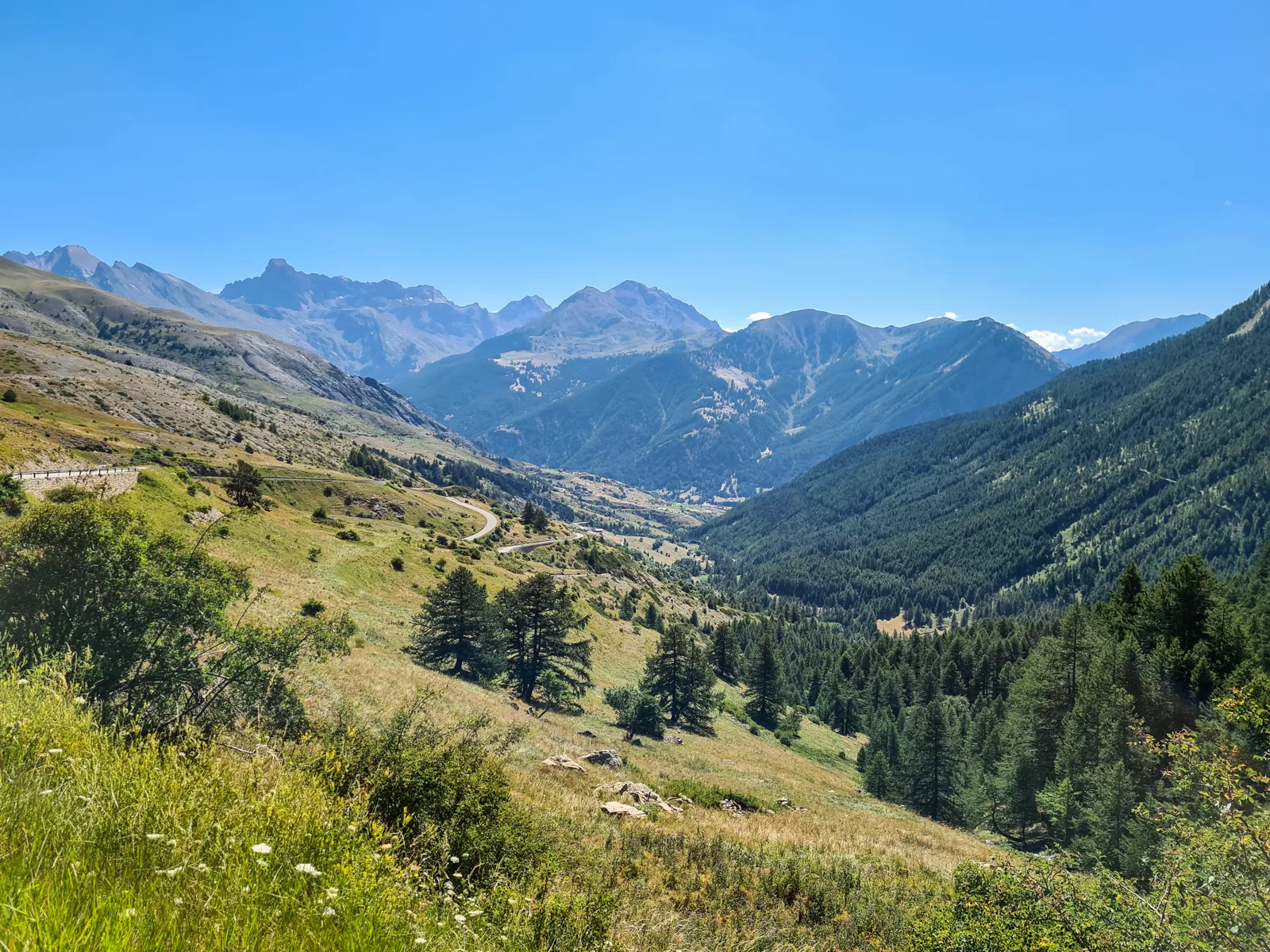
Rest day – Lac de la Douche
A rest day at last! I woke up relatively late and stayed in my tent for a little while (as long as the rising sun allowed). Then, I took a short walk through the fields to the town’s bakery for freshly baked baguettes. Paired with some fromage spread, they were simply incredible. I decided to take the day slowly and focus on resting well. After doing some laundry, I just sat in front of my tent, gazing at the mountains and munching on snacks. The weather was superb. After some time, I got a bit bored and started scouting my maps for a nice, short hike to stretch my legs. I quickly found an interesting route, tossed some water and snacks into a small backpack, and set off.
The walk toward the trailhead was easy and relaxed. Then the path turned pebbly, and the incline steepened. My lightweight barefoot shoes offered almost no padding, so I felt every rock pressing into the soles of my feet. Soon, my heart rate spiked. I grabbed a water bottle from my sack and kept hiking, sipping every few minutes. I gained elevation quickly, and before I knew it, I had left the forest behind, replaced by an open mountainous landscape. A few minutes later, I reached the first landmark of the hike: Lac de la Douche.
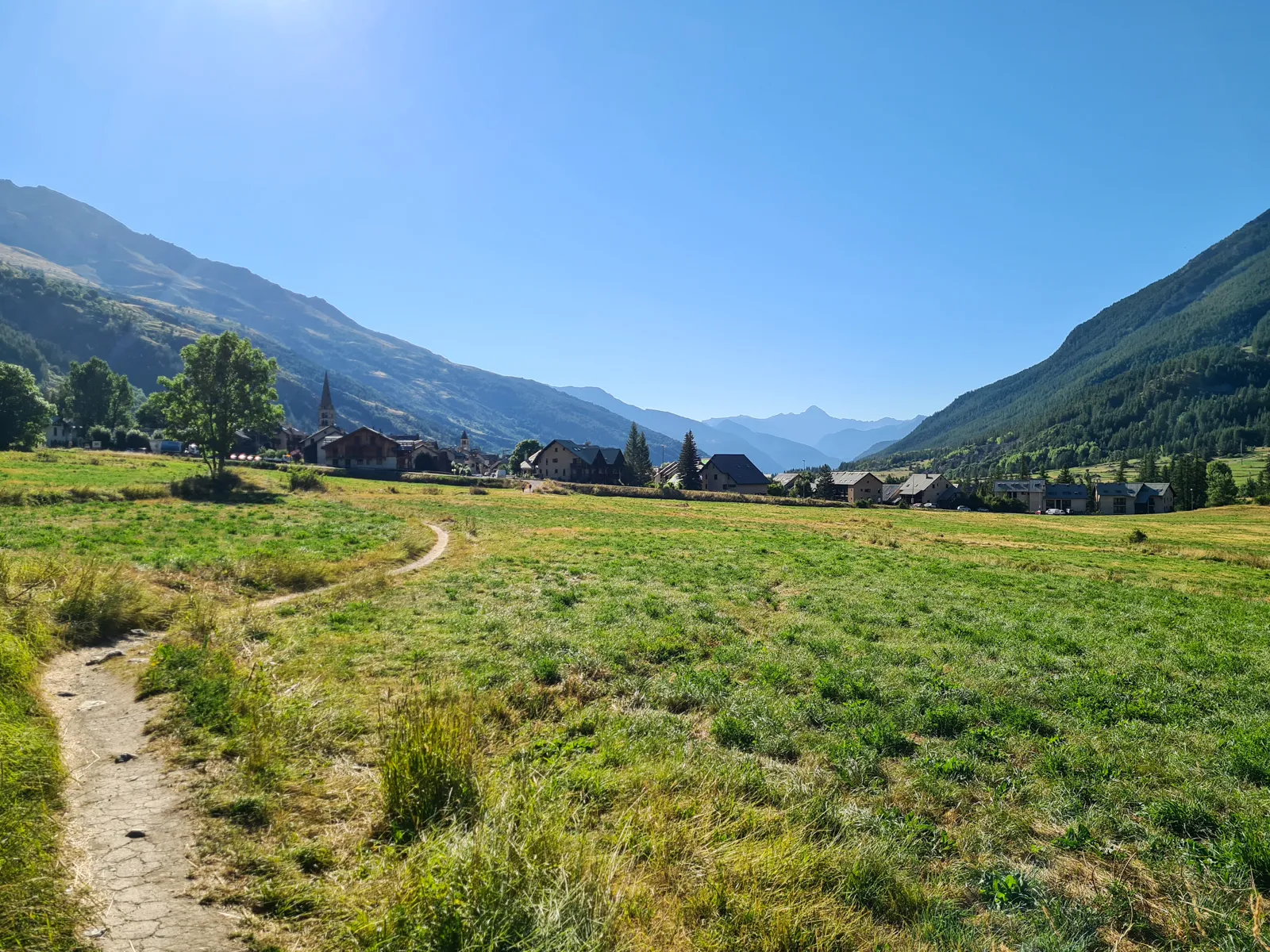
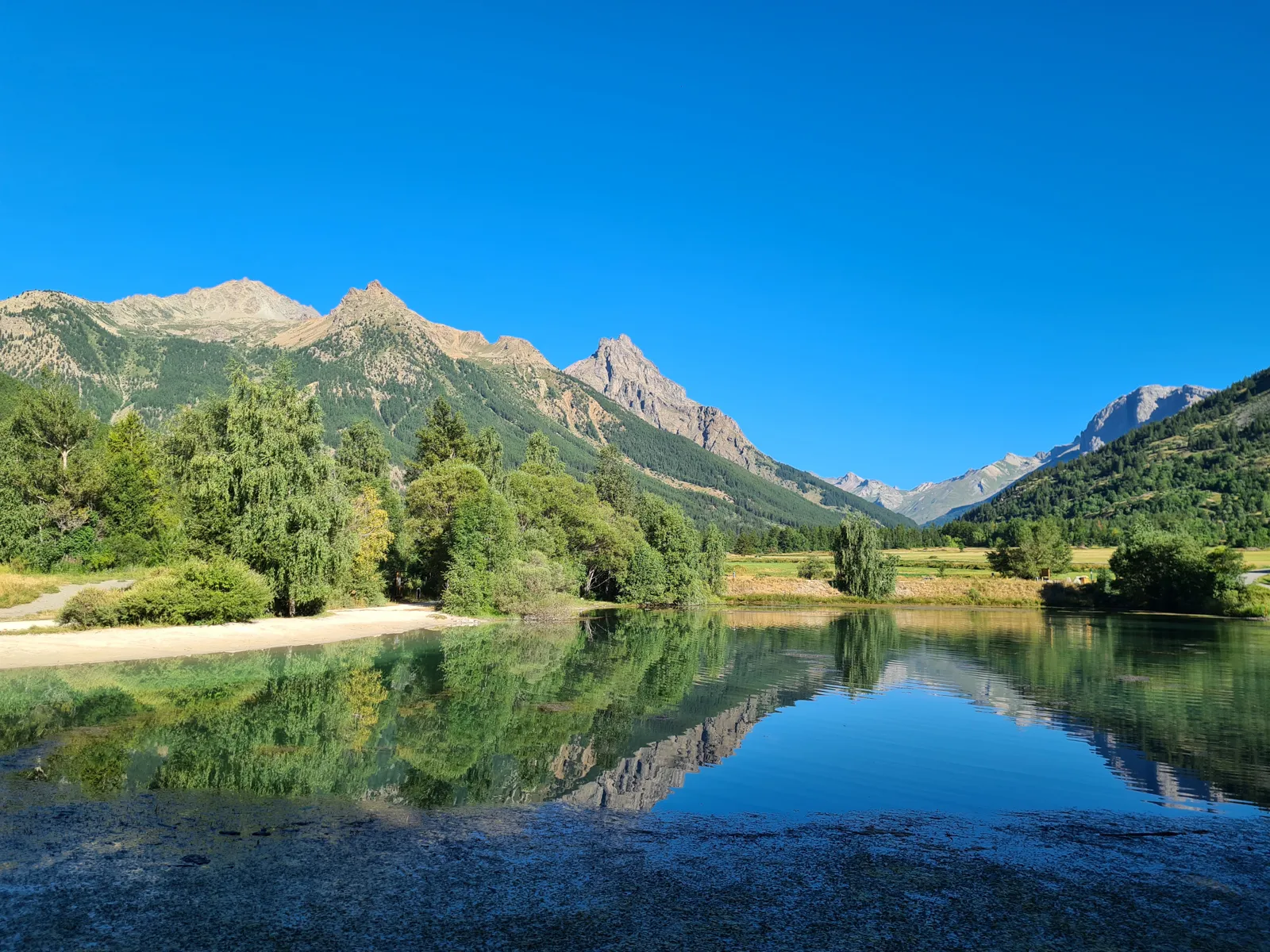
I found a nice spot to rest, sat down, and checked my watch. Of course. Instead of taking a slow, regenerative walk, I had power-hiked the trail. Classic me. Mindful of the exhaustion I experienced the previous day, I decided to cut the hike short and stay by the lake to relax. I knew I could easily complete the rest of the planned trail, but I also was also aware that my poor pacing would lead me to overexert myself again, digging deeper into my body’s reserves instead of working on replenishing glycogen. In the end, I just sat there, soaking in the lake’s vivid color and the magnificence of the surrounding peaks.
On the way back, I discovered that despite having no padding in my shoes, running down the steep sections was easier on my legs than carefully lowering myself step by step. So, I half-walked, half-ran the descent and then took the longer route back to the campsite.
Nothing more eventful happened that day. I enjoyed an amazing burger from a nearby food truck, listened to live music performed by a local artist, and went to sleep, wondering what to do about Col du Granon ascent the following day.
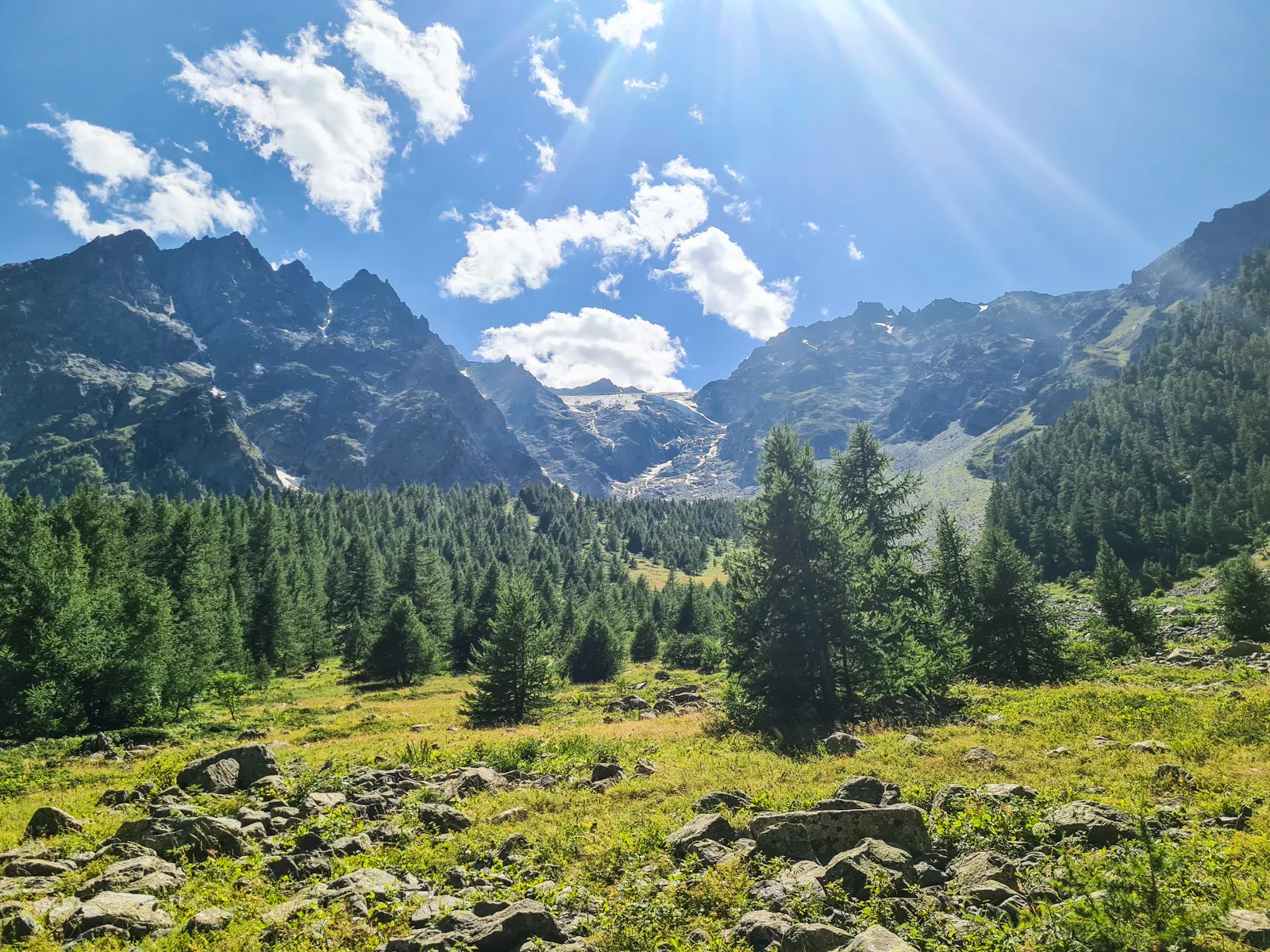
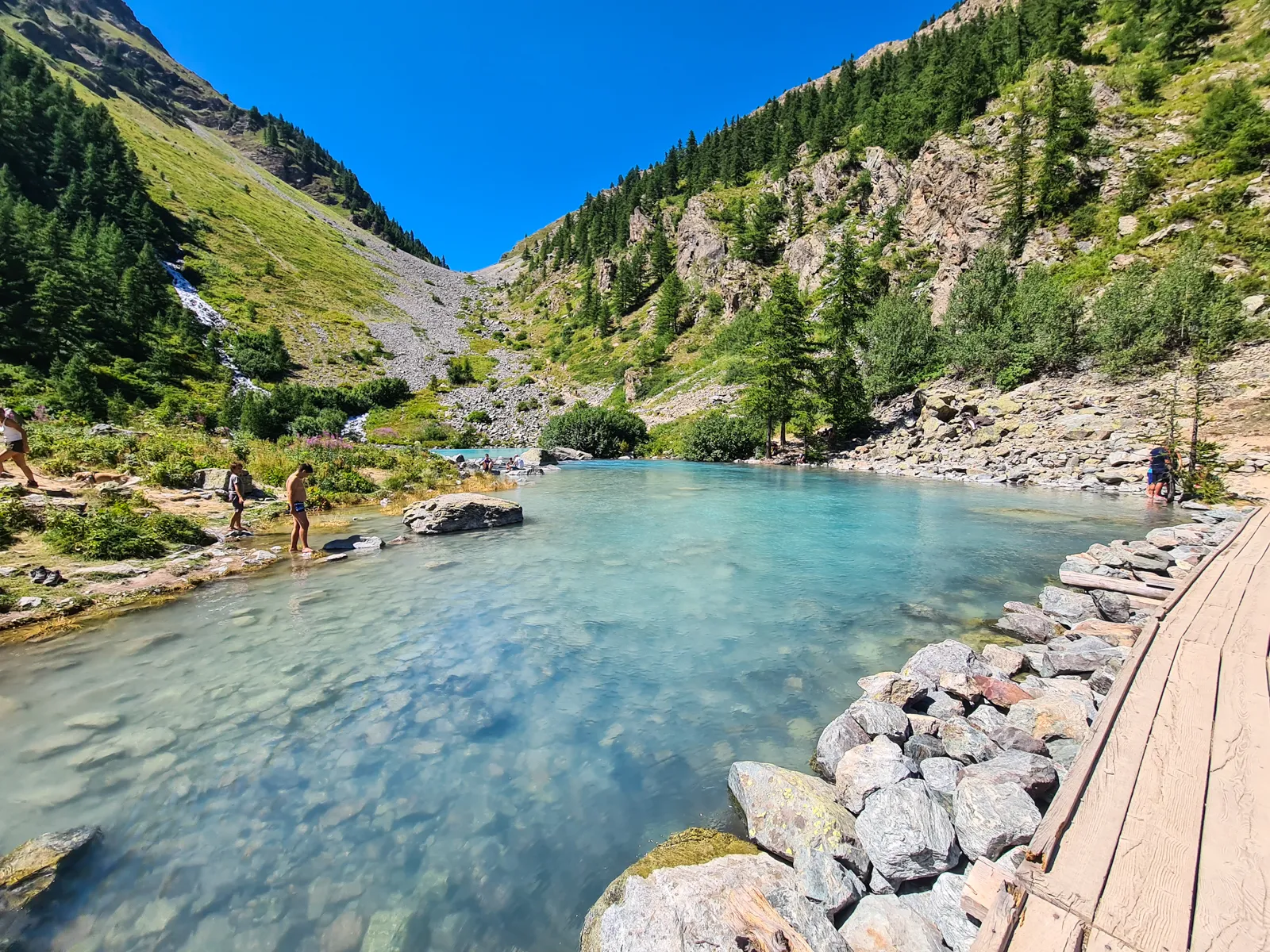
Stage 8 - Le Monêtier-les-Bains to Guillestre
Col du Granon was meant to be the first climb of the day, right after a slight descent. It was the stage for Vingegaard’s dominance and Pogi’s downfall in the 2022 Tour de France, so naturally, I was drawn to it. At the same time, it was a 10 km-long, brutally steep climb averaging over 9% — exactly the kind of challenge I’m attracted to, but also the kind I feared at that moment. Being a cul-de-sac, however, it was easily skippable without altering the overall route.
I felt good — fresh even — and decided to give it a try. I took the turn and gauged how my body would respond to the gradient. After a short descent, the road abruptly angled upward, and just as quickly, my quads screamed in protest. I pushed hard, swaying across the road and fighting tears. Within two minutes, I knew I had to bail. I endured just long enough to reach the nearest crossroads, where I turned toward Briançon. Later, I realized I hadn’t even ridden the canonical part of the climb — my “shortcut” through town was significantly steeper than the main road. Maybe, just maybe, had I known this, I would have tried to ride a bit further. But in that moment, bailing was the only reasonable option.
I rejoined the main road, and minutes later, I was seated in a café in Briançon, waiting for Decathlon to open. There, I stocked up on bars, gels, and dehydrated meals. After taking a stroll through the city center and picking up some souvenirs, I began the slow ascent of Col d’Izoard.
The climb out of Briançon winds through the town’s outskirts, where buildings get gradually sparser with elevation. The scenery transforms into a mix of Alpine meadows and forests, with the road carving along the valley’s edge. To the right, glimpses of a stream appear below, flowing through a relatively shallow gorge. The landscape was entirely different from the other side of the valley, which I had ridden from Ville-Vieille three years prior. Yet, it reminded me of how much I loved this pass and why I had to visit it again.
The road, up to this point, was easy — averaging less than a 5% gradient. I kept my effort light, riding on the edge of Zone 2 and 3. Then, the village of Cervières came into view. Since I had bailed on the Granon climb earlier in the day and felt somewhat unsatisfied, I decided to take a detour I’d been eyeing for days.
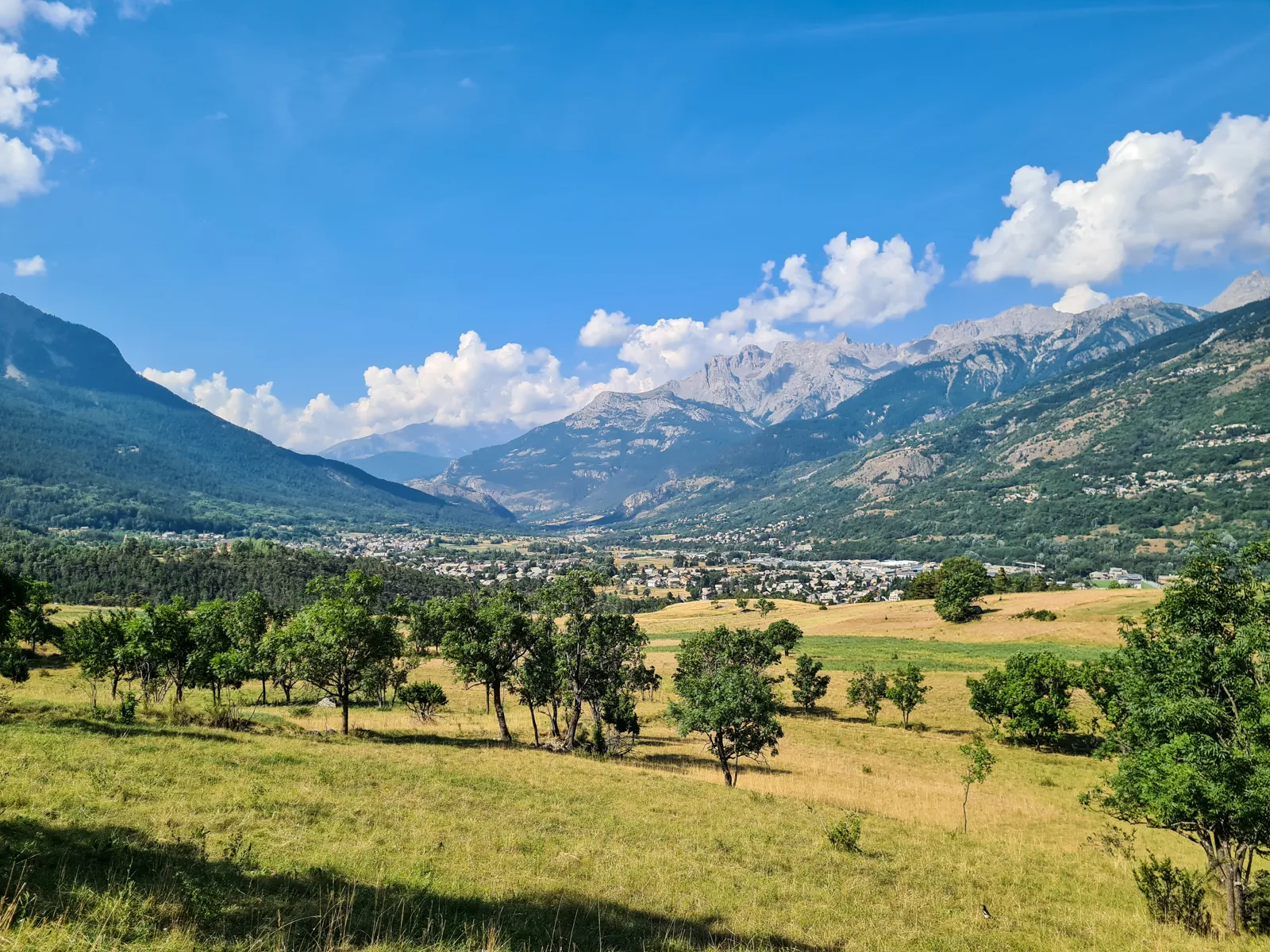
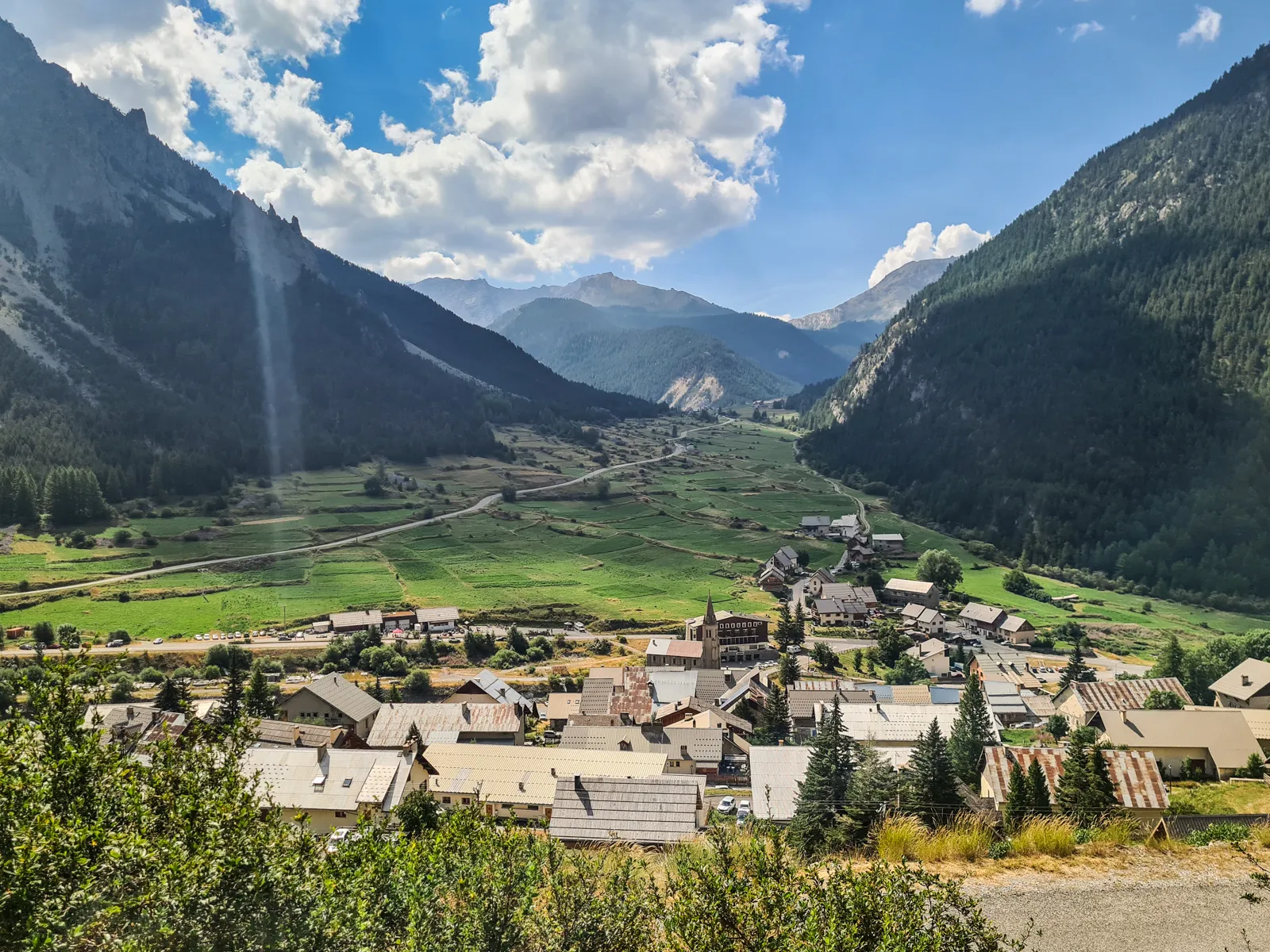
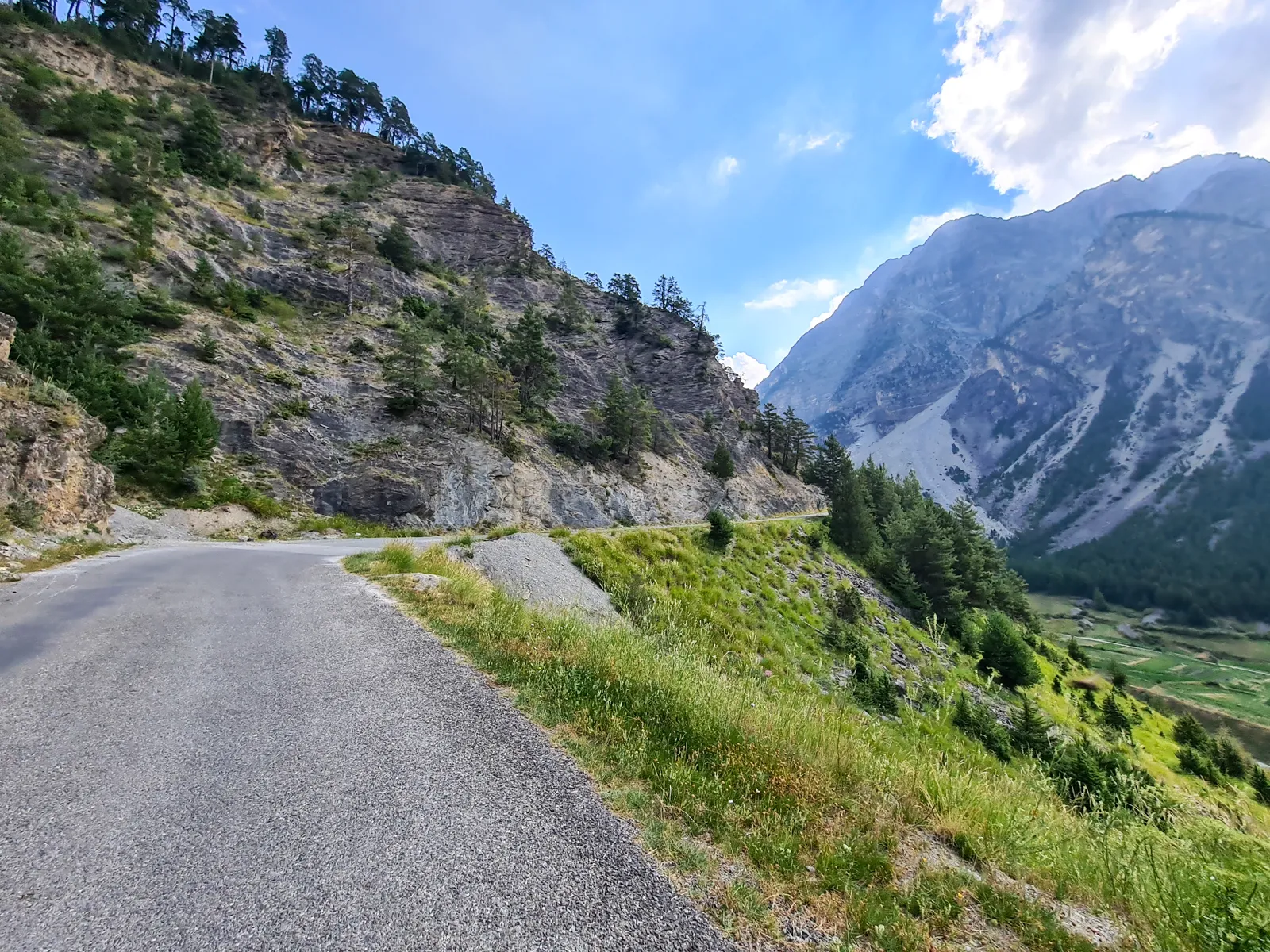
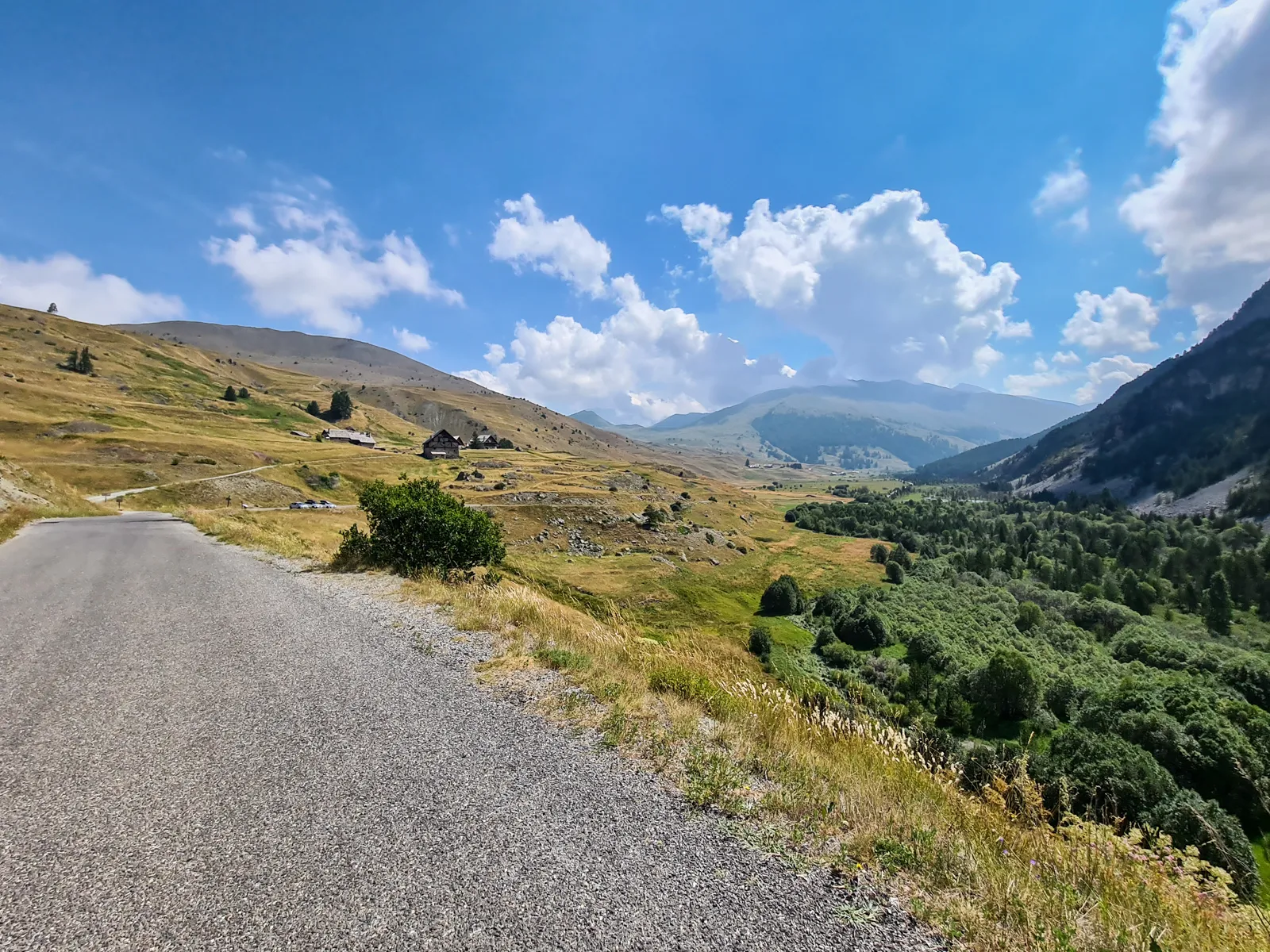
The climb from Cervières toward Les Fonts begins with a steady 3-kilometer ramp at a 7% gradient. The narrow road, with its deteriorated surface, sees almost no traffic. It winds along the valley wall, offering stunning views of Cervières below and the main road toward Izoard in the distance. Soon, the road passes through remnants of the Alpine extension of the Maginot Line and continues as a nearly flat roll along the valley floor. Eventually, the paved road ends, giving way to a hike-a-bike trail — part of the harder Torino-Nice Rally stage, an alternate to the Izoard pass. I stopped there, resting and savoring the tranquility before turning back.
Descending through the tiny hamlets, I rejoined the main climb in Cervières. The gradient soon started progressively growing harder, finally stabilizing just below 9%. Upon passing the picturesque hamlet of Le Laus, the road led me into a dense forest, where I stuck to the narrow bike lane on the road’s edge, steadily gaining elevation. Deep in Tempo zone, I worked hard but kept the effort sustainable. After what felt like endless hairpins, the forest suddenly opened up, revealing a stunning panorama of surrounding peaks. Seconds later, I spotted the Refuge Napoleon perched above, signaling I was close to the summit.
The final stretch was a series of switchbacks flanked by sparse trees, shrubs, and stone walls supporting the road’s edges. I pedaled deliberately, maintaining low cadence and controlled power. Finally, the last turn came, and I rolled to the pass, greeted by the familiar view beyond the crest. I was thrilled to have conquered the climb in a steady, controlled manner, especially after abandoning Granon earlier that morning.
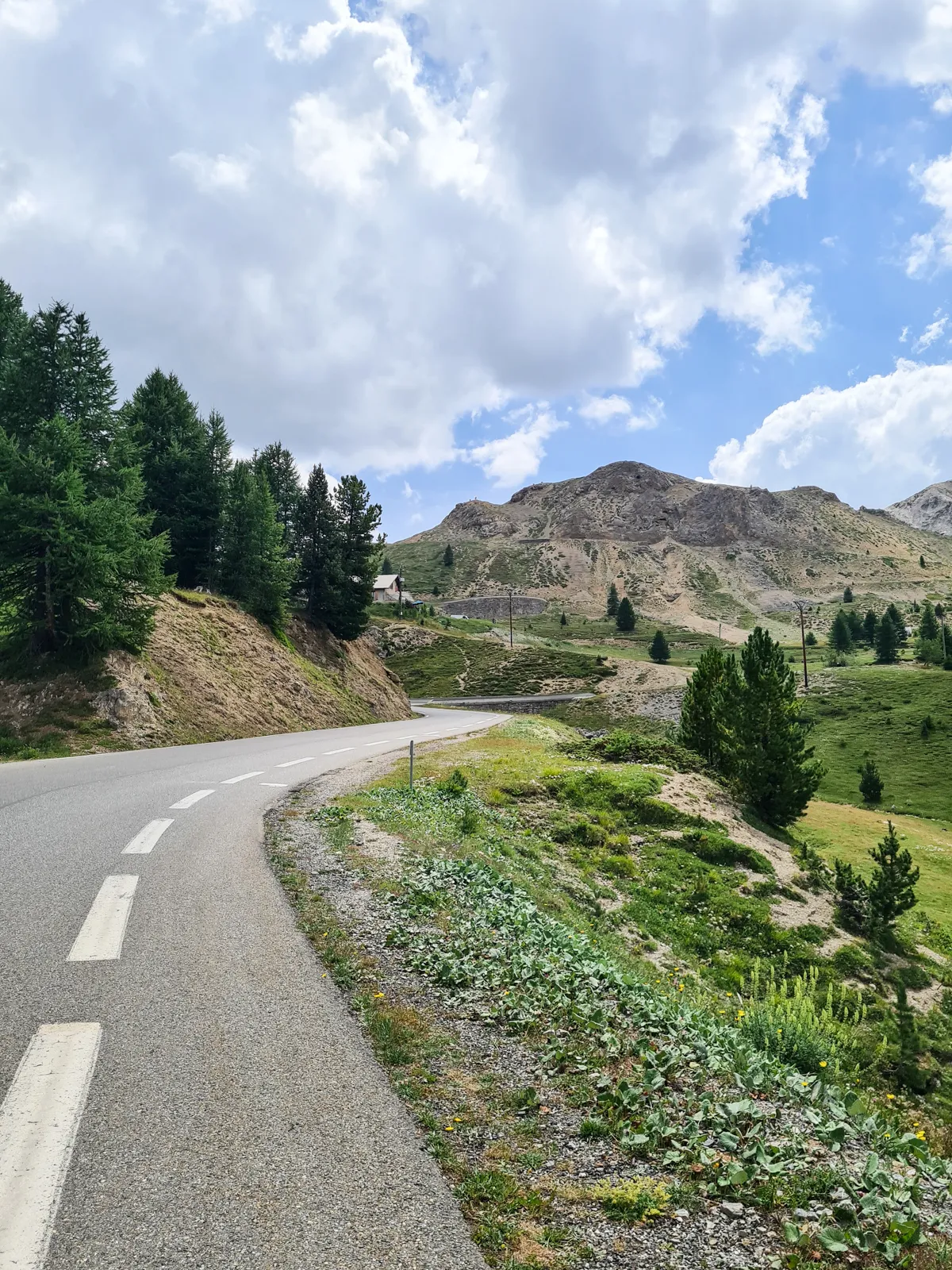
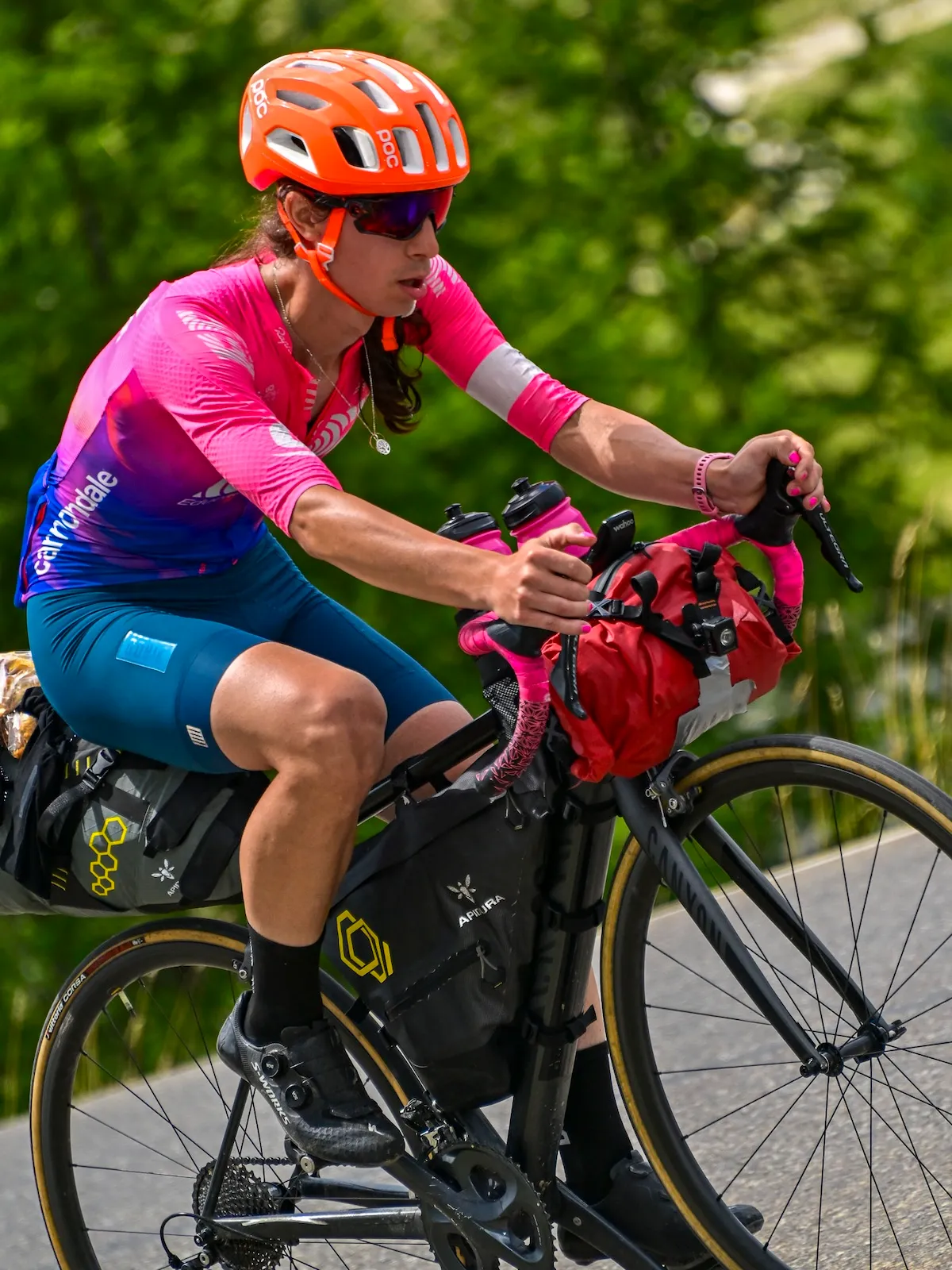
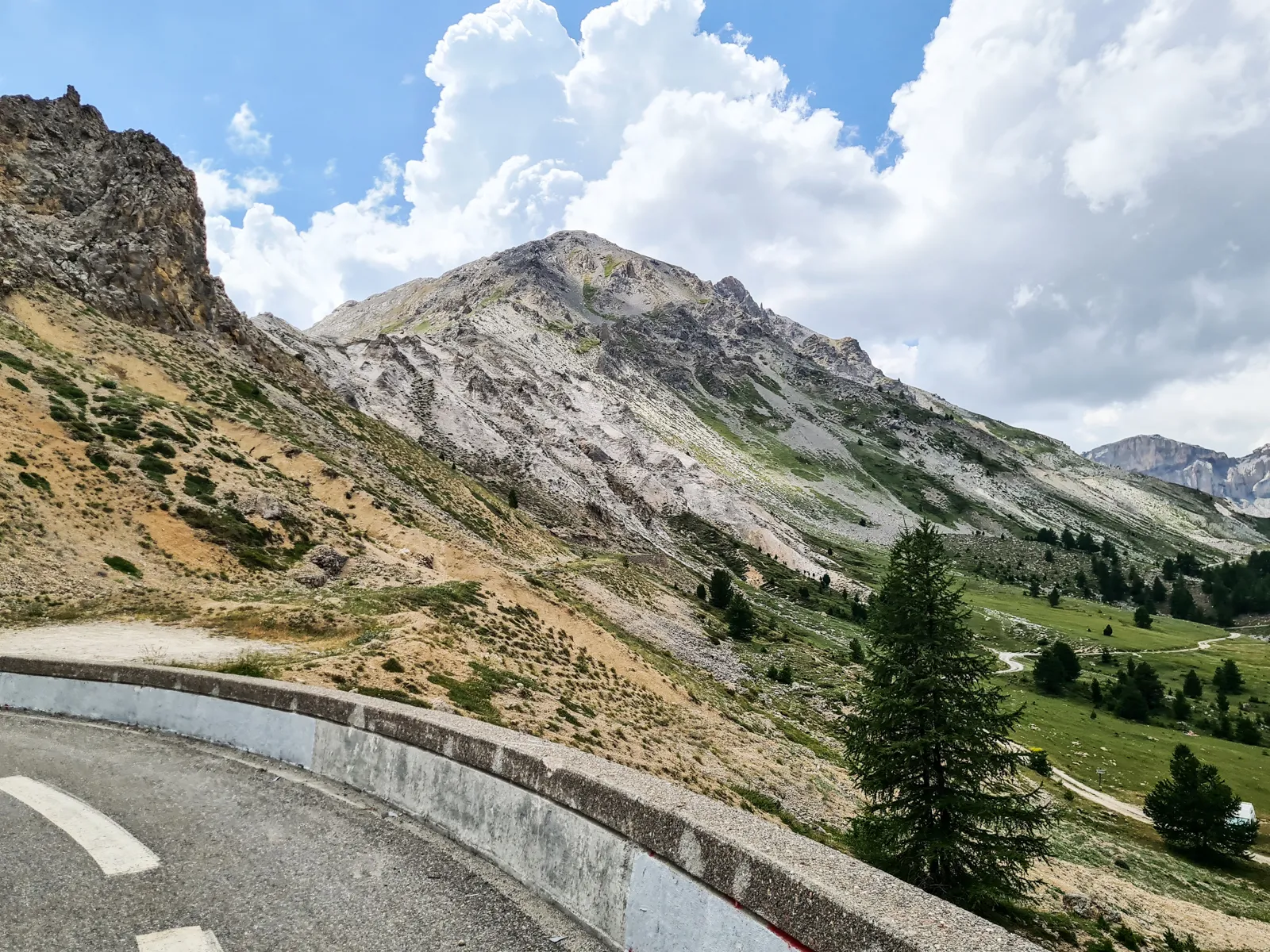
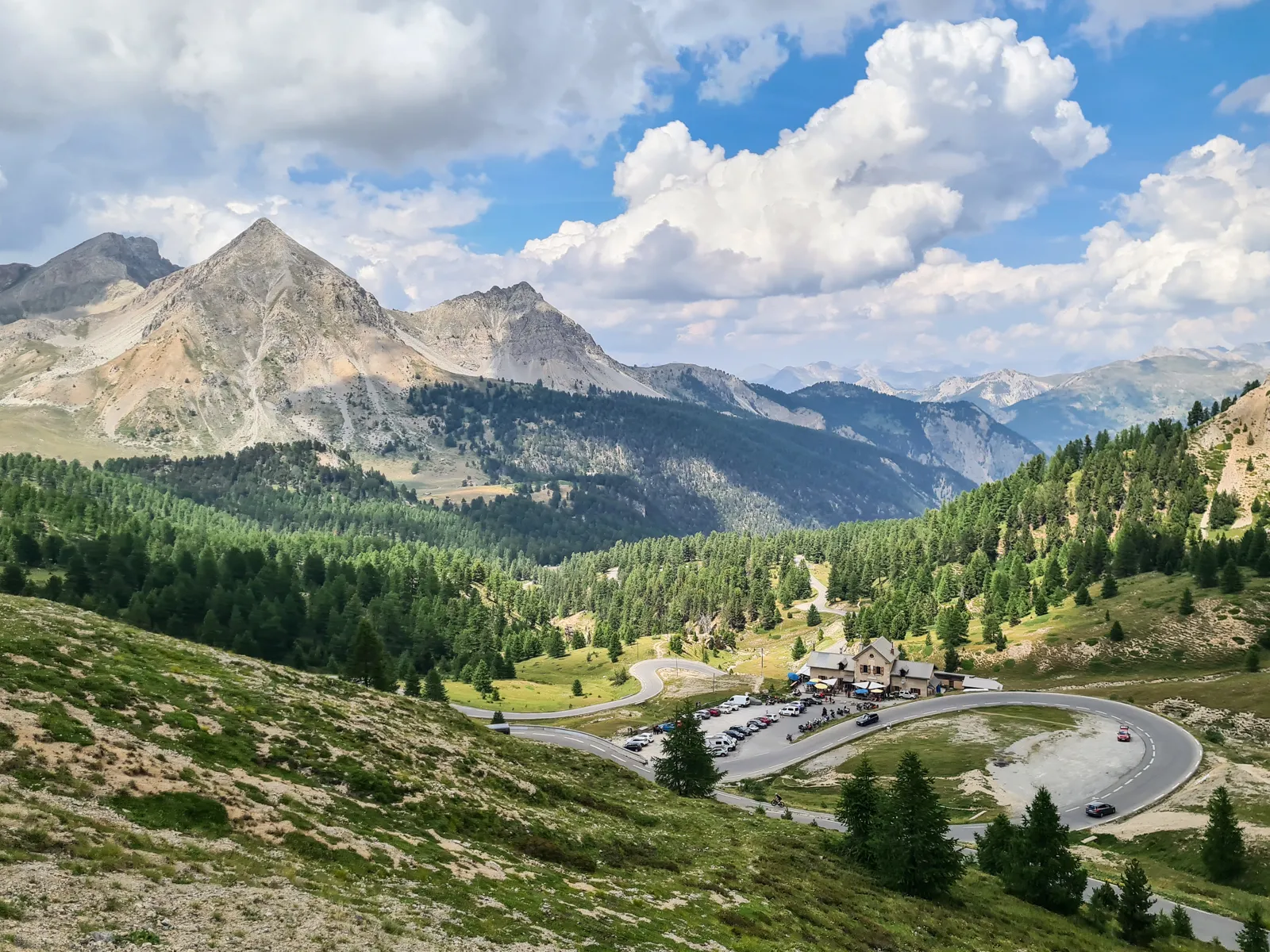
I enjoyed pastries I had bought in Le Monêtier and attempted to buy some memorabilia — small fridge magnets — from the pass. Unfortunately, the kiosk didn’t accept cards, and having used no physical money throughout the trip, I had to abandon the idea.
As the wind picked up and the air grew chilly, I’ve put on my jacket and began the descent. I started slowly, taking in the views. This was, after all, my favorite stretch of road in the Alps. The first short set of hairpins led me to one of the area’s most surreal place — La Casse Déserte. This barren, rocky landscape below the pass is often compared to a moonlike terrain. For me, its contrast with the lush green forest just a hundred meters below made it one of the most magical places I’ve ever cycled through.
At the end of La Casse Déserte, the road briefly climbs before plunging into steep switchbacks through the forest. Familiar with this section, I let go of the brakes, accelerating hard out of every turn and reveling in the thrill. When the forest ended and the road straightened into the valley, I tucked in to gain speed. Unfortunately, I was soon blocked by a slow-moving truck. With no room to pass, I had to adjust my speed until the vehicle moved away in the lower section.
After a fast, flowing stretch below Arvieux, I reached the main valley road leading to Guillestre and Ville-Vieille. This flat section along the river was lined with scenic, forested walls. I maintained a steady, high speed, spinning lightly through the stunning surroundings. The valley then narrowed into a series of dramatic gorges, with steep rocky formations enclosing the road. It gently winded along with the river, creating a visual spectacle of water, rocks and forest. Eventually, passing high river dam, the road climbed above the gorge on a balcony, opening spectacular views from above the river, passing through a series of tunnels before descending straight into Guillestre’s city center.
Being a Sunday, all the grocery stores were closed. I parked at a crêperie in the square and indulged in a chocolate crêpe with lemon ice cream — a treat, but not one to sustain me for long. I then followed my route to the campsite, pitched the tent, and, after a quick shower, headed back to the city center for a well-earned pizza.
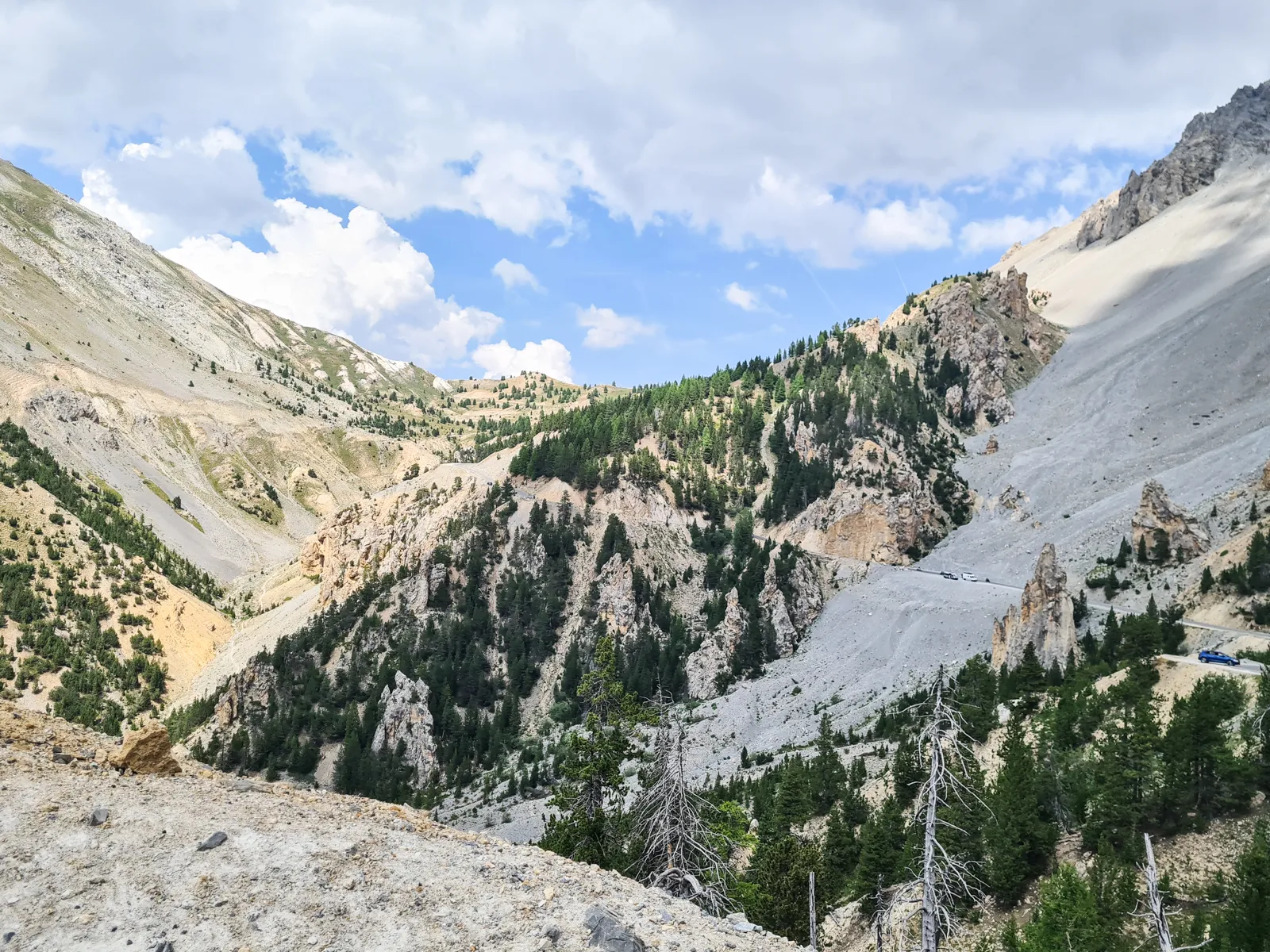
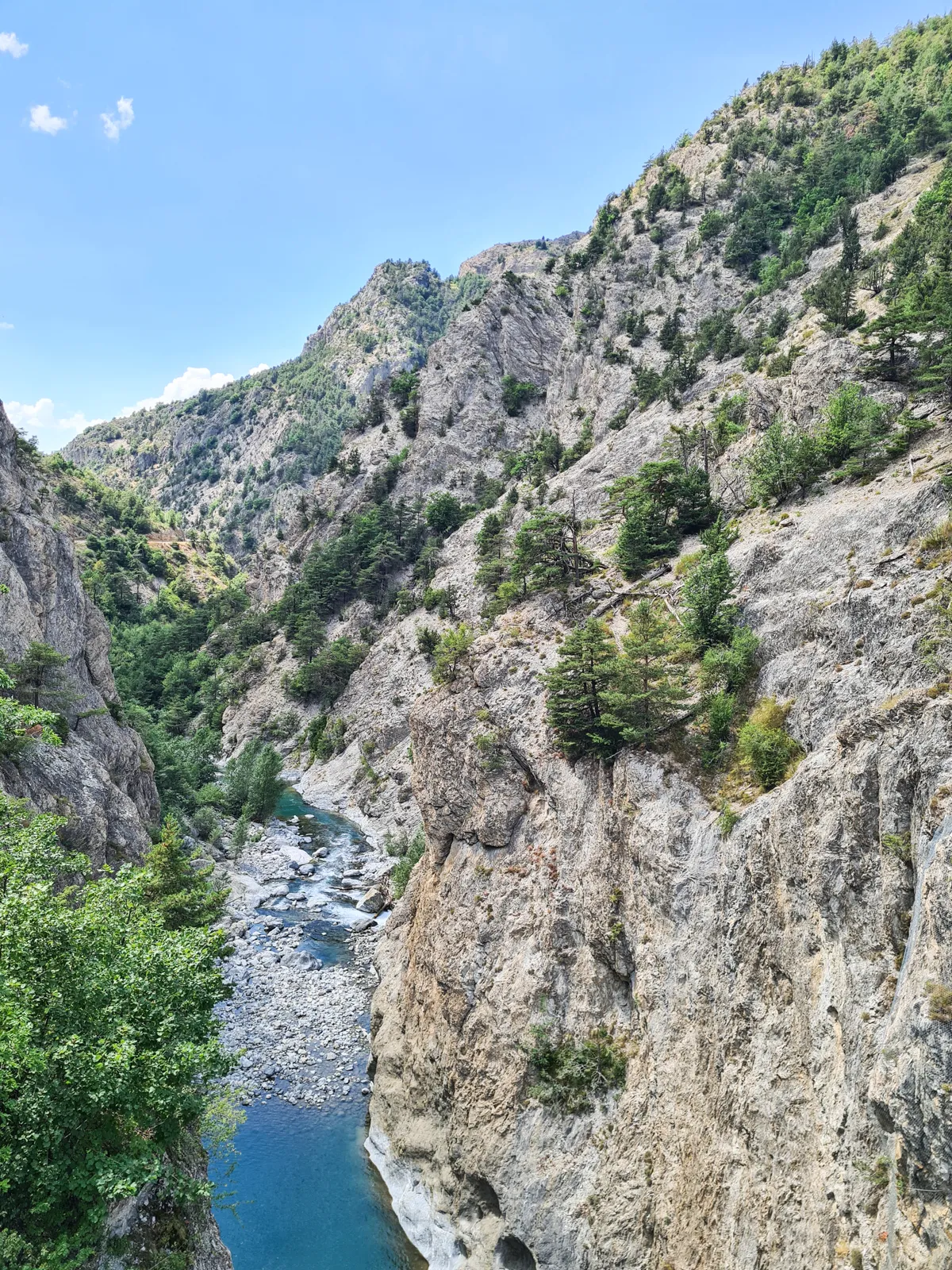
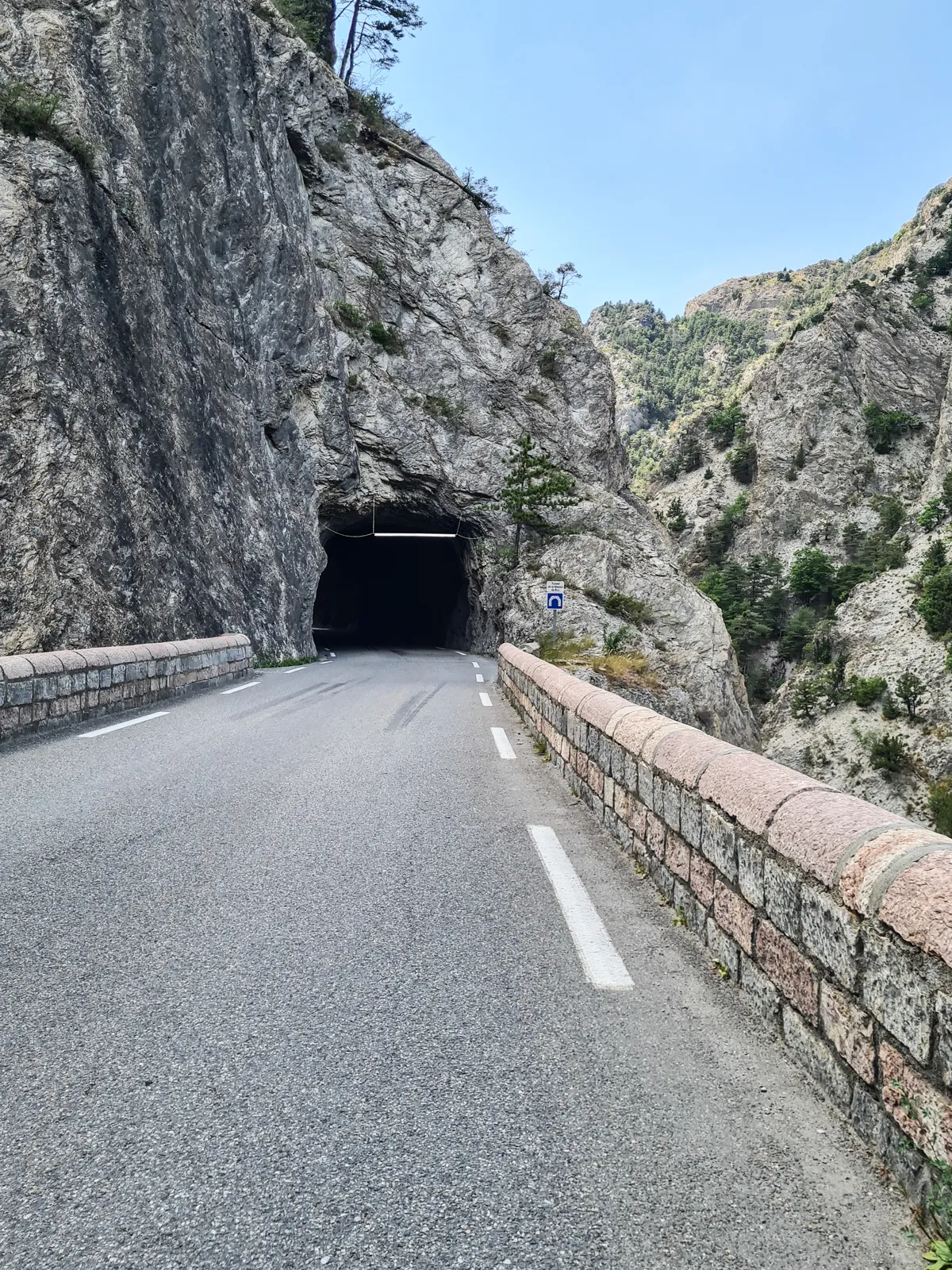
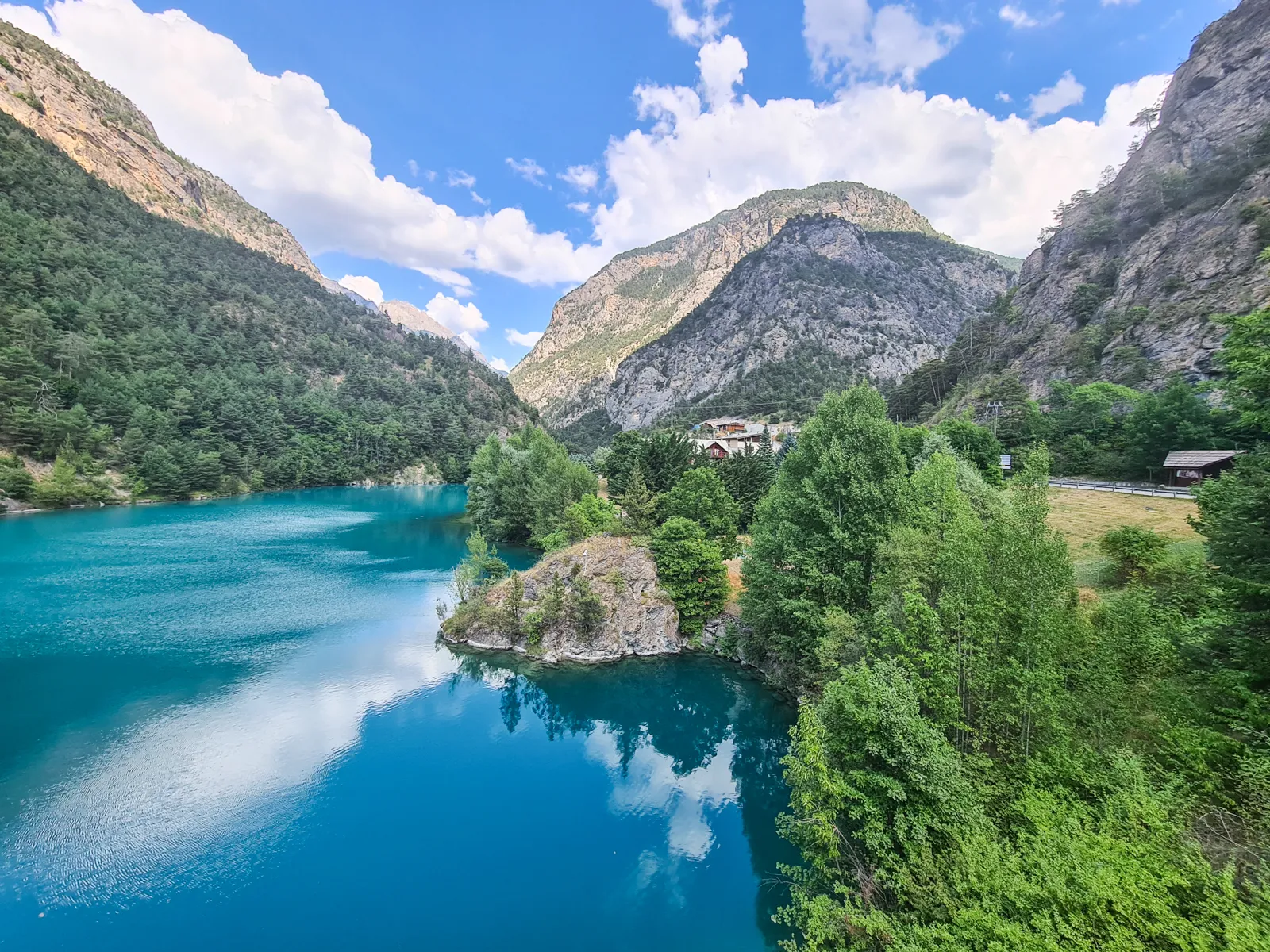
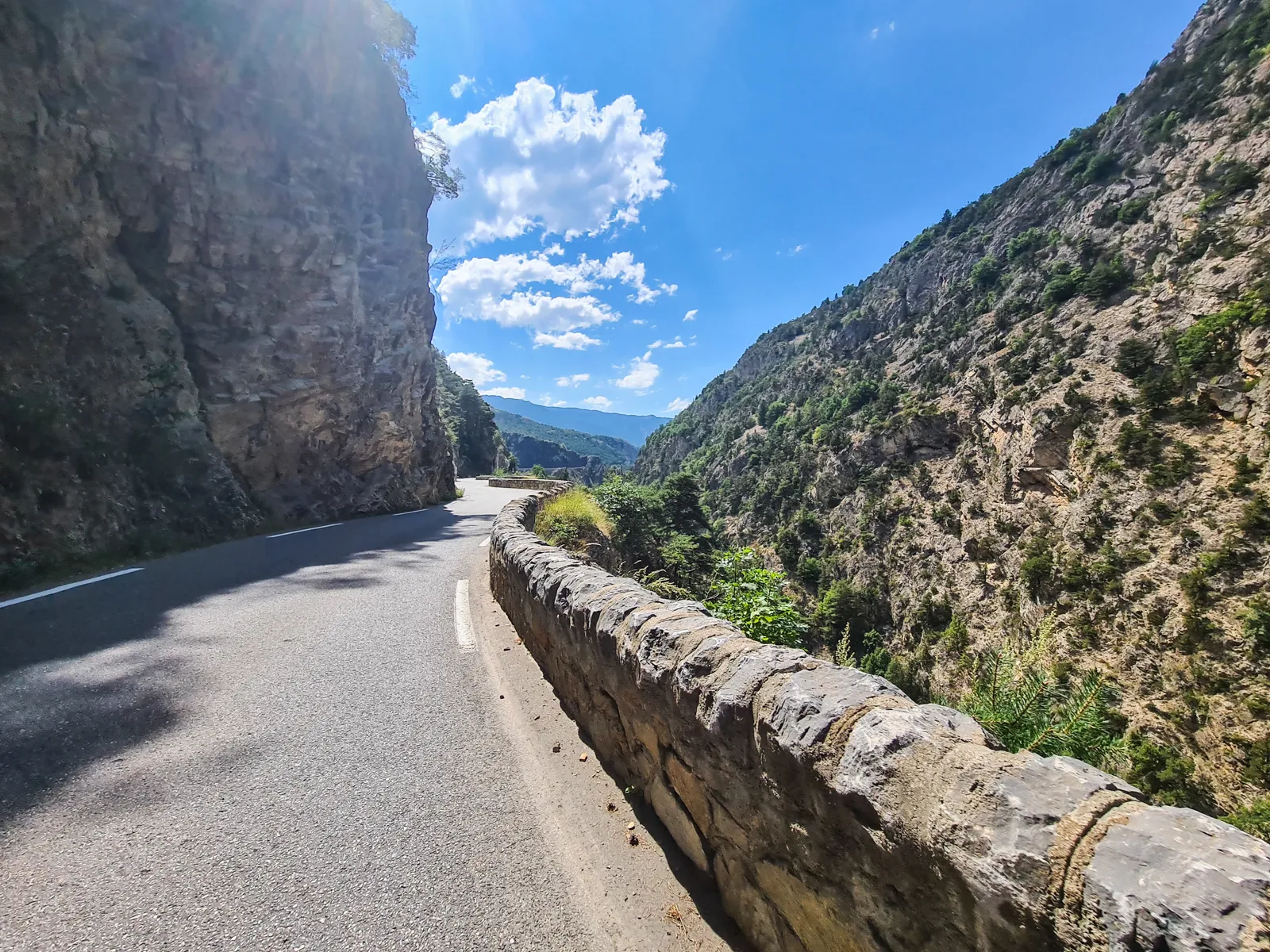
Stage 9 – Guillestre to La Condamine-Châtelard
As I hadn’t been able to get any food the previous day, I started my morning with a pre-made porridge for breakfast. After packing up, I said goodbye to the German pensioners I’d befriended the afternoon before and hopped on my bike, targeting Col de Vars. It’s a smaller climb, with just over 1,000 meters of elevation gain. Given the state of my legs, I planned to keep this ride short — just one pass and an early finish.
The road to Vars starts abruptly, with the first half being the steepest, peaking at around 11%. It winds its way out of the city and up to a ridge, then continues climbing through a mix of thickets, cliffs, and meadows, offering an ever-changing landscape. The biggest downside, though, is that it’s the main access road to the village of Vars, so it’s heavily trafficked by trucks, which diminishes some of its charm.
Whenever I ride — loaded or not — I find myself comparing my performance to other cyclists around me. “Comparison is the thief of joy,” you might say, and you’d be right. But even deeply immersed in the romantic side of cycling, soaking up the emotions of the movement and the beauty of your surroundings, if you’re a racer at heart, you’ll always race. Against the clock, against yourself, to hit a target speed, be it lateral or vertical — or against the people around you. When someone overtakes you, you can’t help but assess whether they’re objectively stronger. But when you close in on a group of riders about your age, pass them, and feel the adrenaline spike, it’s exhilarating. In that moment, despite knowing you’ll pay the price later, you invertedly put a bit more power than you’d want. The endorphins surge, and you feel alive — truly happy!
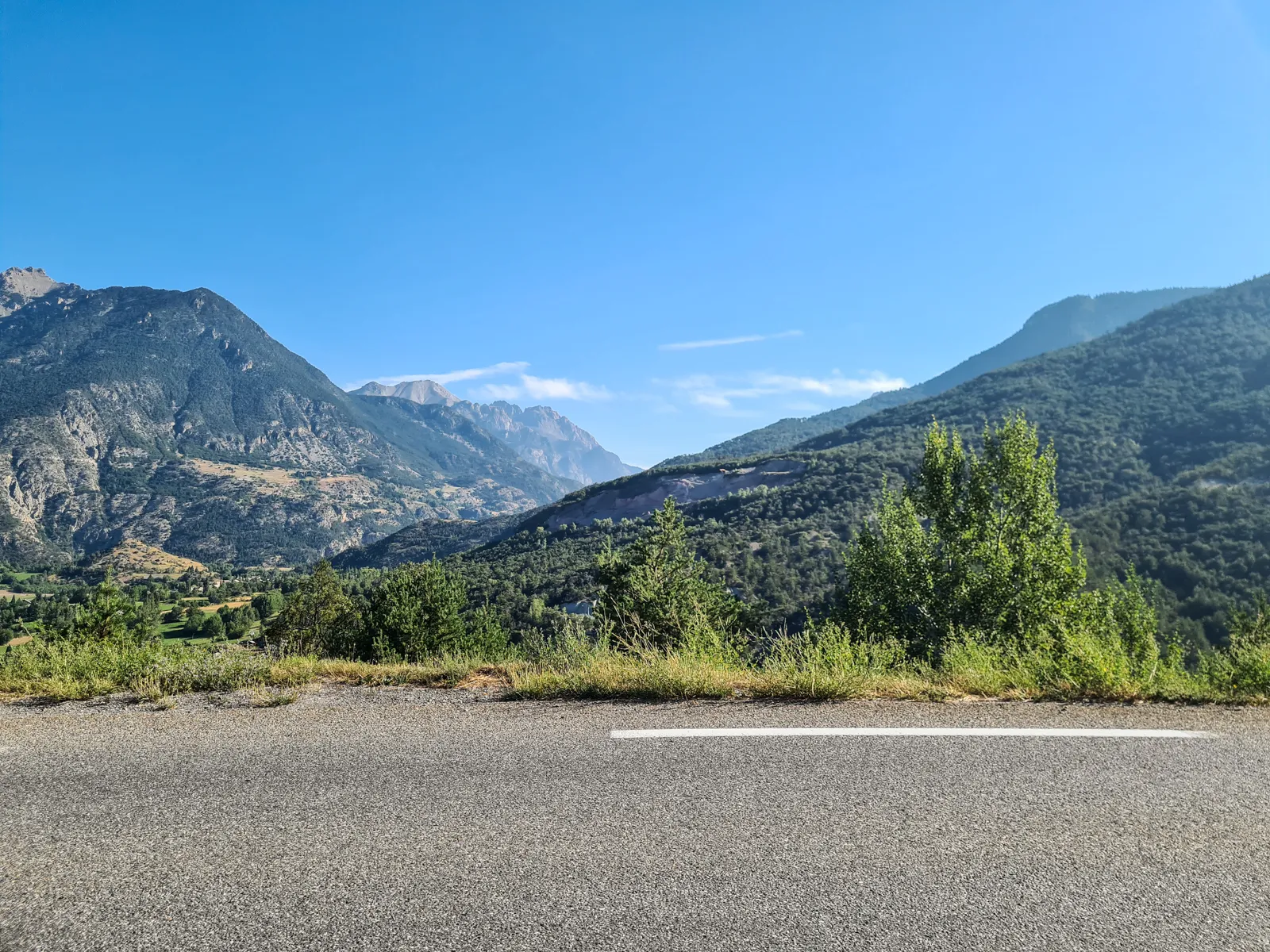
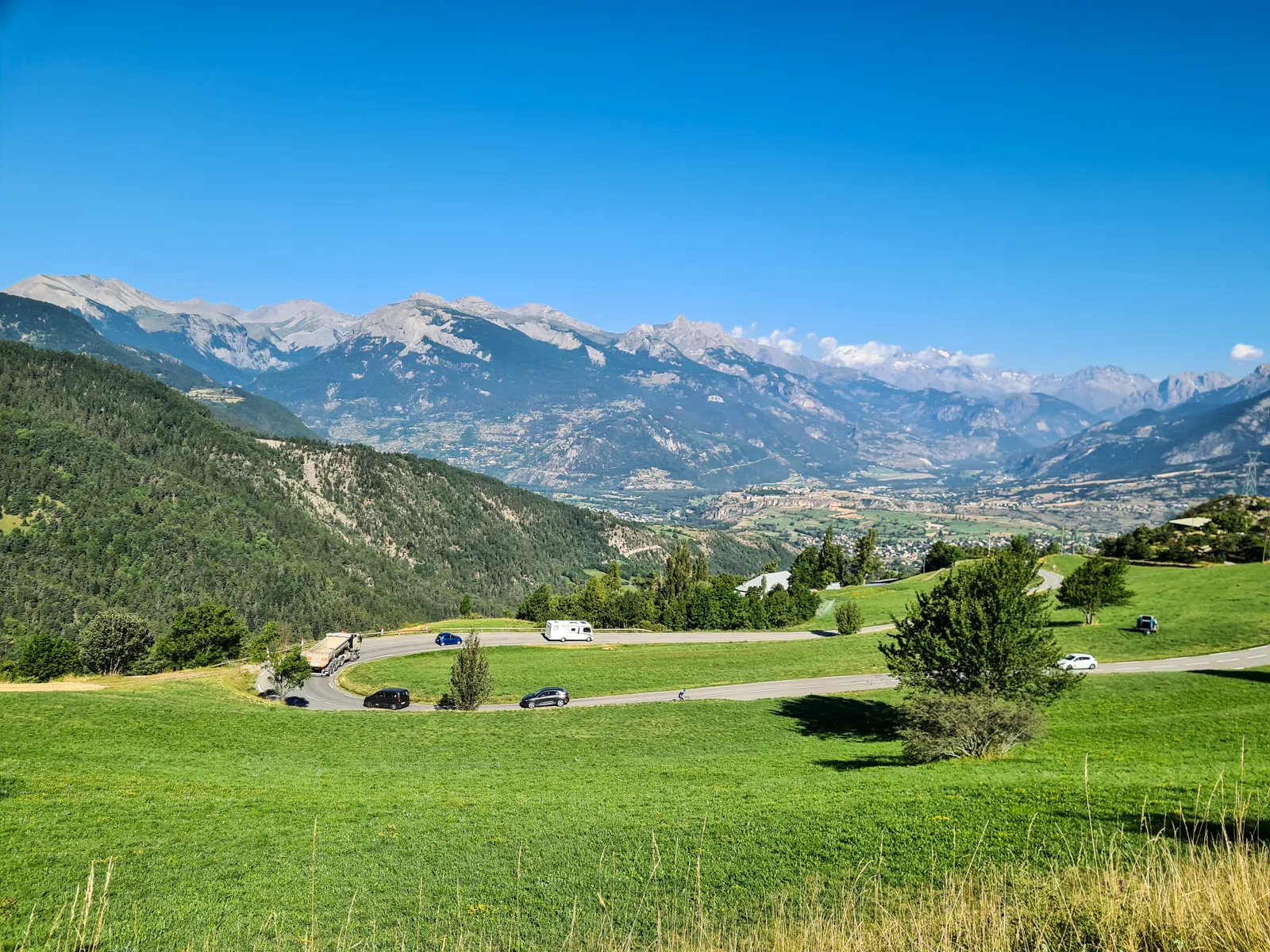
Through the bottom half of the climb, I probably pushed a bit too hard, especially given my fatigue. Despite fueling regularly, I was thrilled to reach the flatter section running through the lower part of Vars village. However, the relief was short-lived. As the road resumed its climb into the upper part of the village — lined with ski resort buildings and construction sites — the exhaustion and pain caught up with me. This time, though, I didn’t feel defeated. I accepted it as a moment to rest, and after a brief pause, I was back in the saddle, grinding my way up the busy road.
Once I passed the resort’s outskirts, the road shallowed out, allowing me to ease off the power and ride more conservatively. The buildings disappeared, replaced by Alpine landscapes that rekindled the joy of the ride. Playing little mind games with myself — not for motivation or survival this time, but for fun and enjoyment — I rode the final 3 kilometers in good spirits, even spotting a fun-looking enduro/XC trail alongside the road. Maybe one day, I’ll come back to try it out!
I summited with a big grin, once again mesmerized by the stunning view that unfolded beyond the ridge. After snapping a quick picture of the pass, I dove into the steep descent. Feeling completely in control, I let loose, confidently speeding down and sprinting past slower descenders, while still braking safely into every hairpin. The scenery was breathtaking — still distinctly mountainous but with a touch of southern charm in the greenery, reminiscent of Provence.
The top section of the descent ended as abruptly as it began. I continued along the road, spinning casually until I reached the town of Jausiers. There, I picked up some groceries, threw together improvised sandwiches and snacks, and started toward the campsite.
When I arrived, I was greeted by a disappointing “No Free Spaces” sign. A quick conversation with the staff confirmed there was no convincing them otherwise. They wouldn’t yield to my pleading. Resigned, I felt the weight of my fatigue. The owner suggested riding to Barcelonnette, but I wasn’t keen on adding more distance to an already taxing day. Then, I remembered seeing an ad for another campsite not that far up the valley. After checking Google Maps and making a quick call, I was relieved to hear they had free pitches.
I ended up backtracking about 6 kilometers along my route, where I found myself at a marvelous campsite nestled in a small forest. I pitched my tent among the trees, and after eating my post-ride freeze-dried meal and taking care of my usual chores, I treated myself to a well-deserved, but late dinner at the local restaurant.
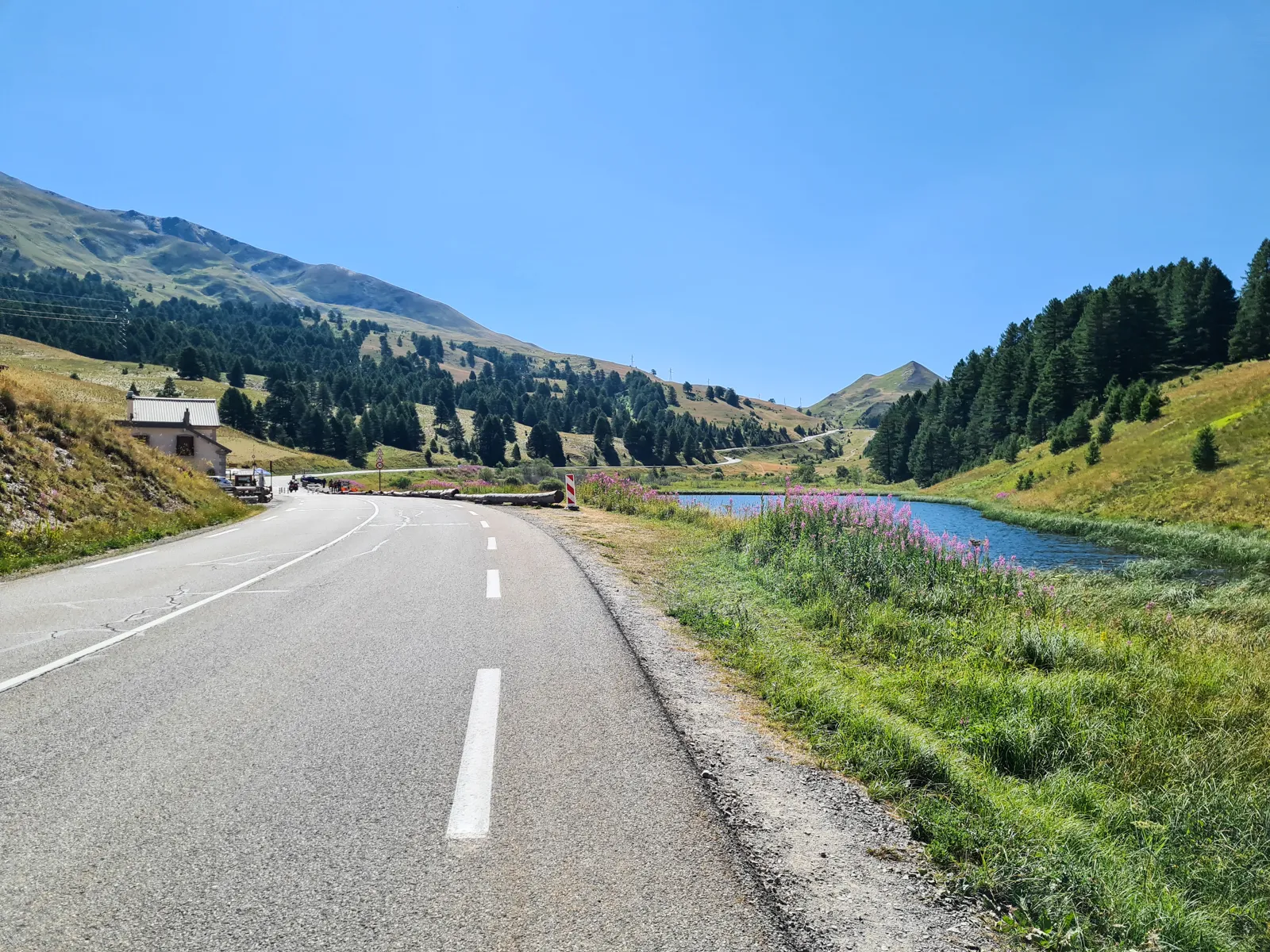
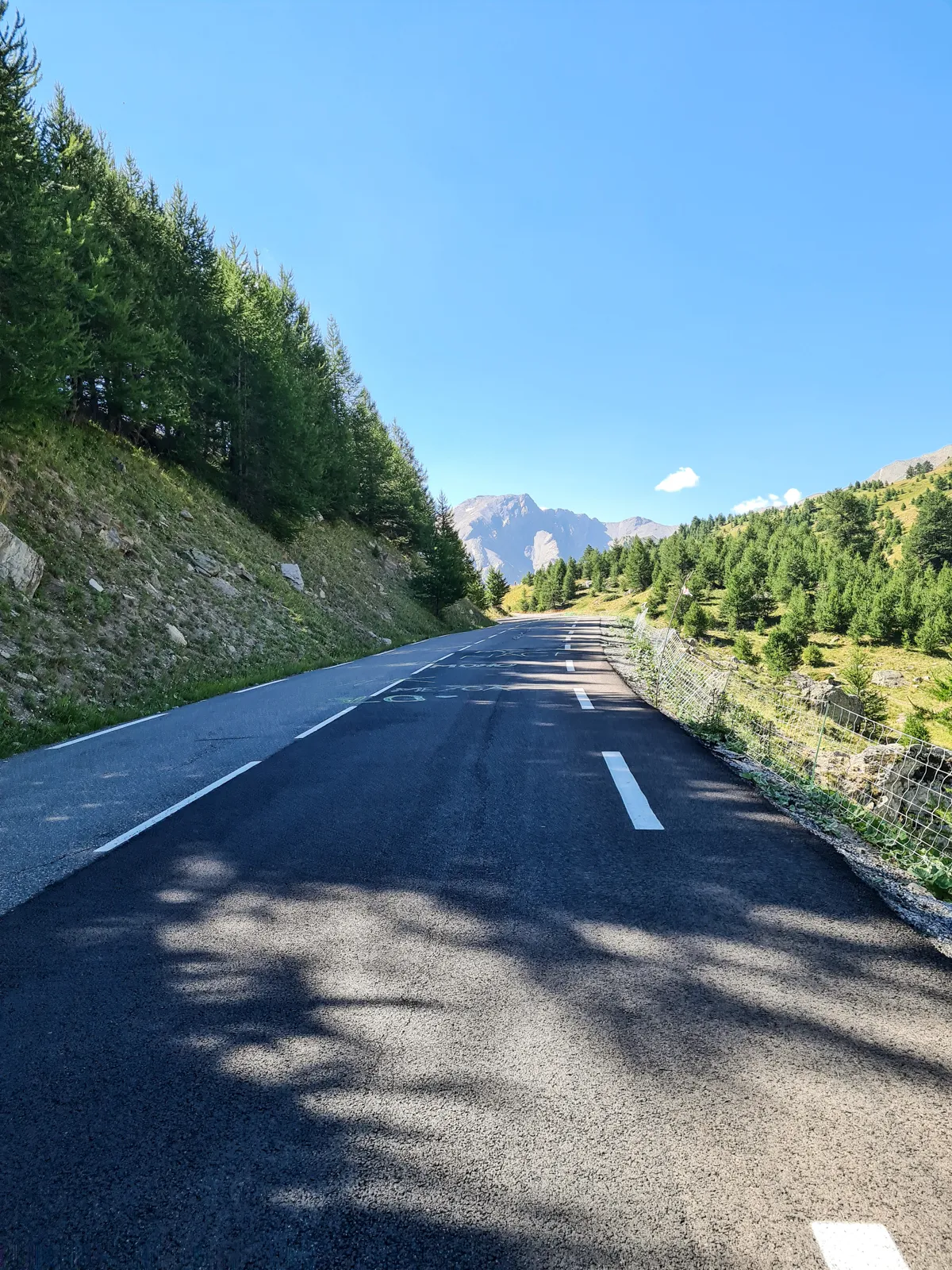
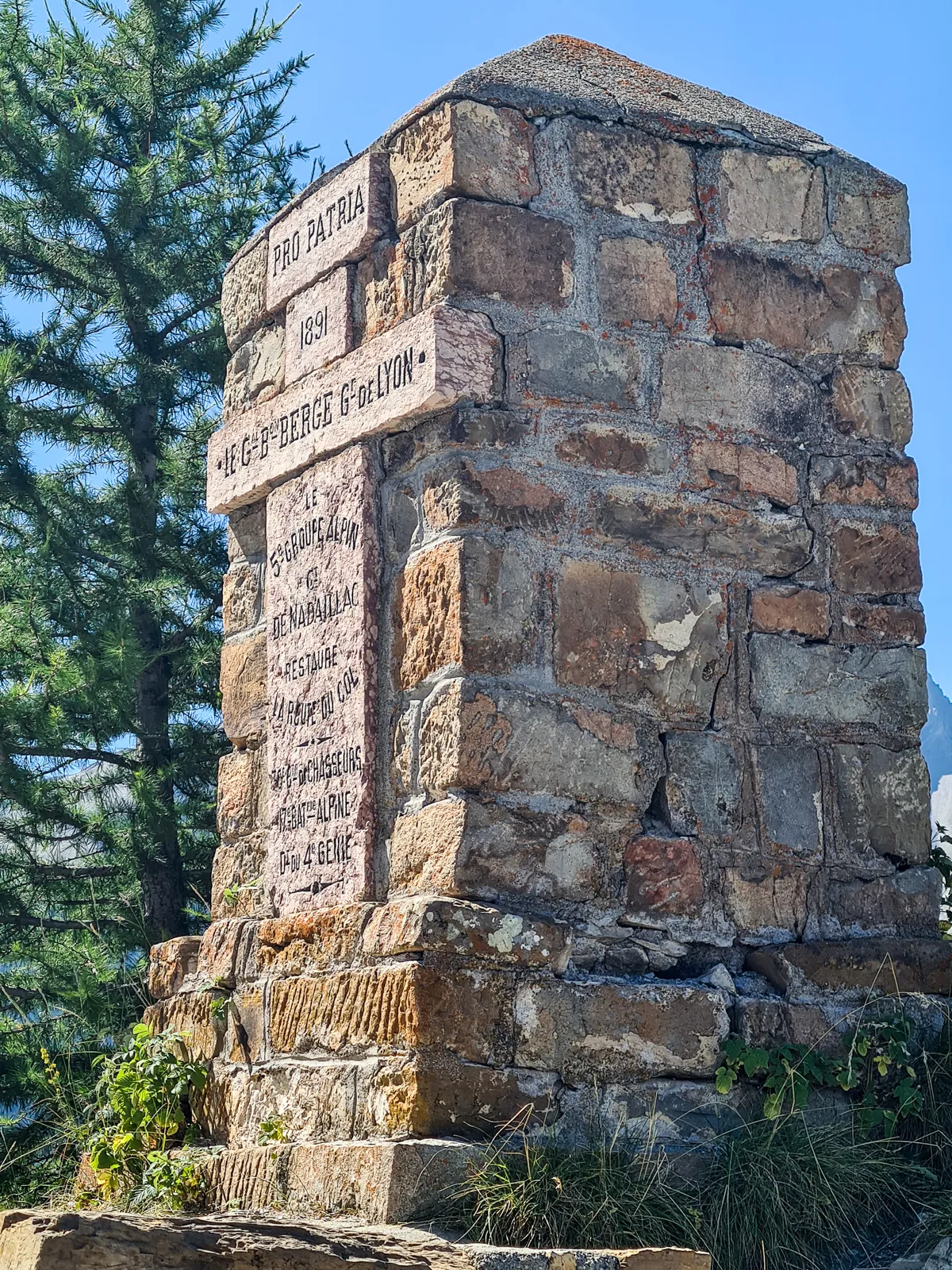
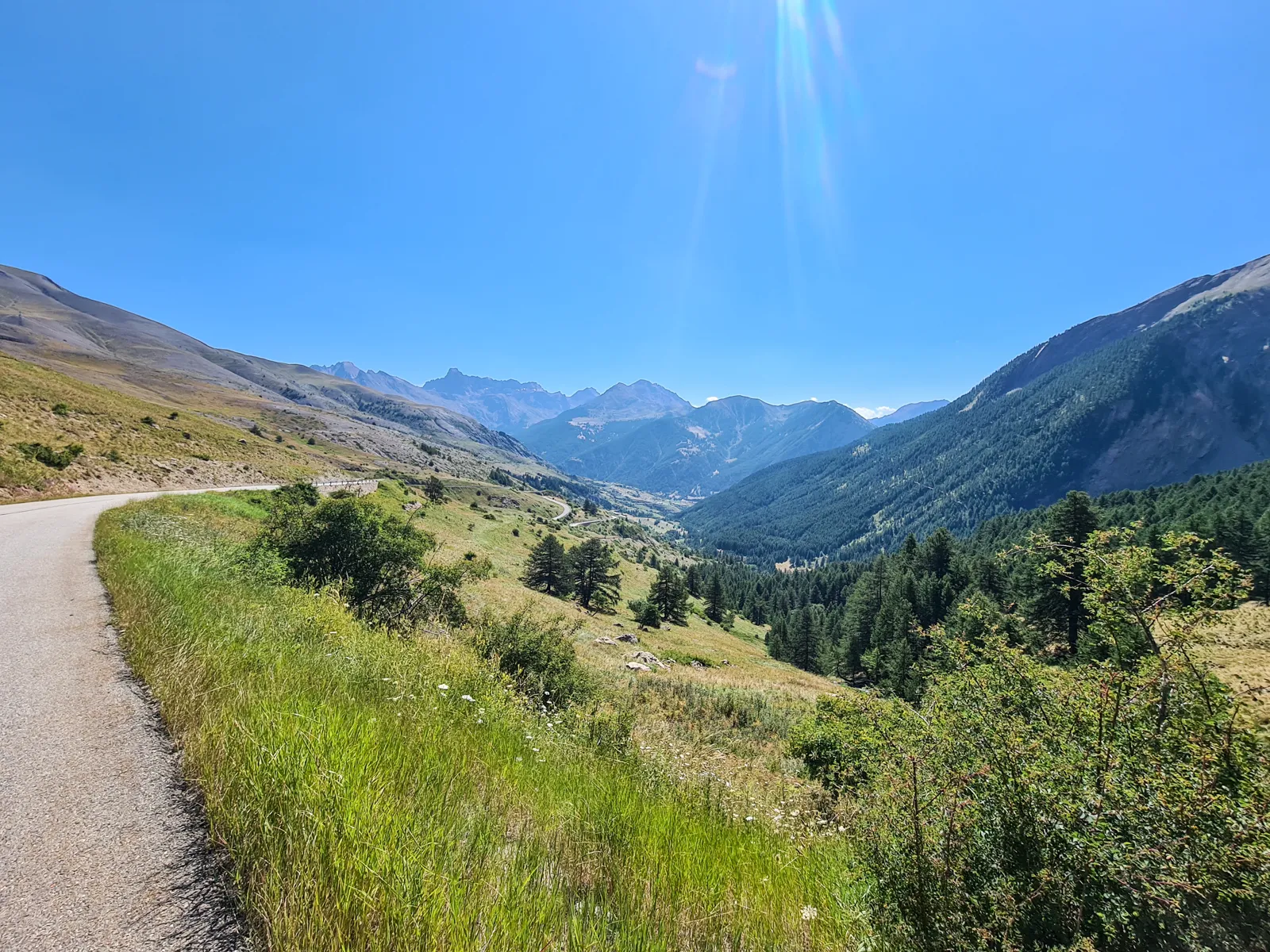
Stage 10 – La Condamine-Châtelard to La Condamine-Châtelard
I slept in, finally being able to ride a facultative excursion — without luggage, at last. But first, breakfast. I pedaled to the hamlet of La Condamine-Chatelard and indulged in the offerings of a tiny local bakery. Well-fed and satisfied, I continued to Barcelonette and turned towards Col d’Allos, a lesser-known pass in the Ubaye region. It’s part of a longer loop through three passes: Allos, Champs, and Cayolle.
I knew the road to Allos was officially closed, but I had heard rumors that it might be passable by bike, so I decided to take the chance. The climb began gently, with the road snaking up the valley wall via a narrow balcony cut into the rocky cliff. It was a mellow ascent, the perfect contrast to the previous days of grinding climbs. With my bike light and free of luggage, I could spin effortlessly — a welcome respite for my legs. Best of all, there was no car traffic.
About an hour in, I reached the roadblock. The upper stretch was closed for renovations. I stopped at the barrier, as if waiting for someone to appear and grant me permission to continue. No less than 10 minutes later, a few descending cyclists confirmed that while the road was rough and broken in places, it was rideable, and there were no workers or patrols to stop me. I ducked under the barrier and resumed the climb.
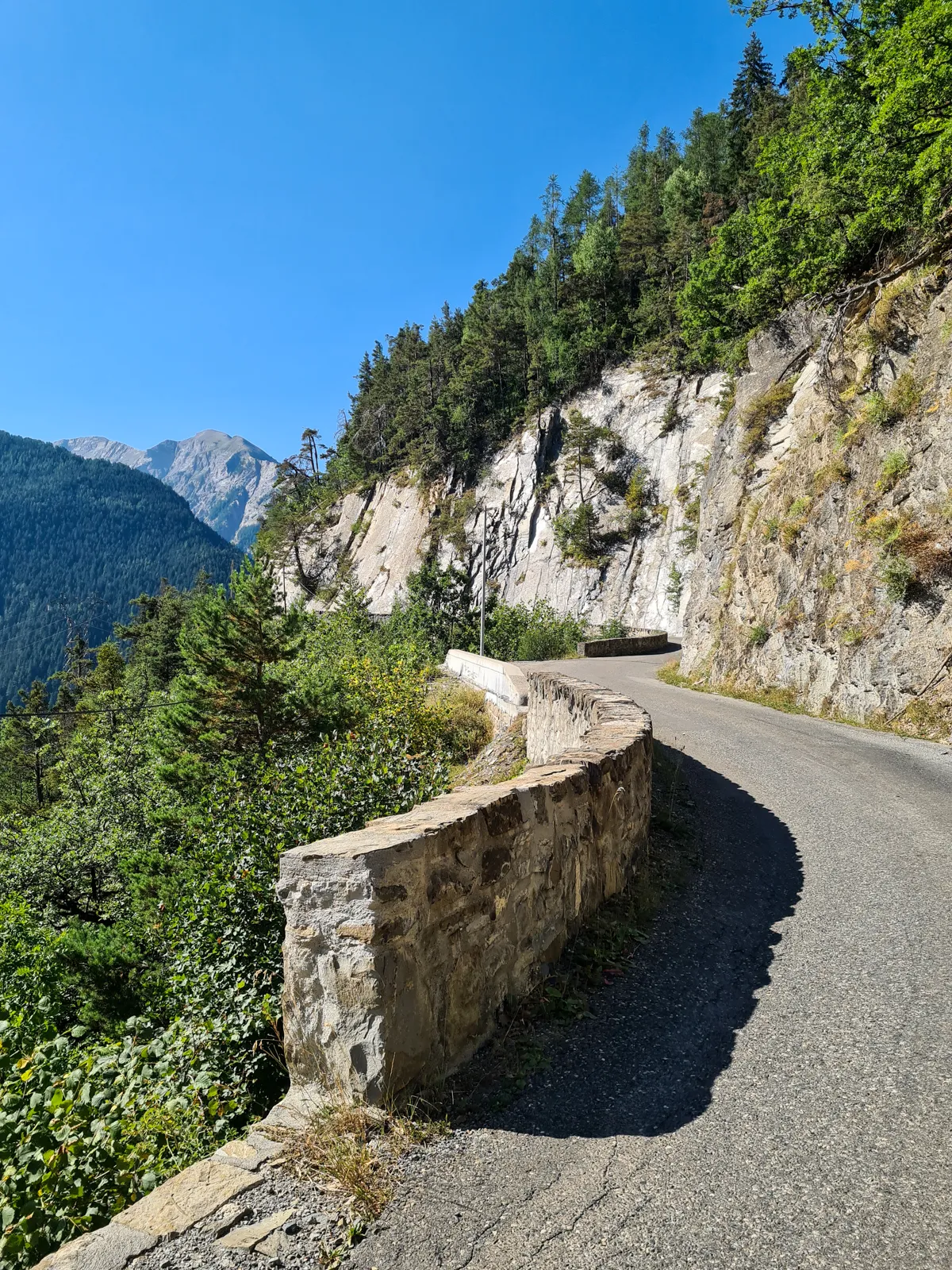
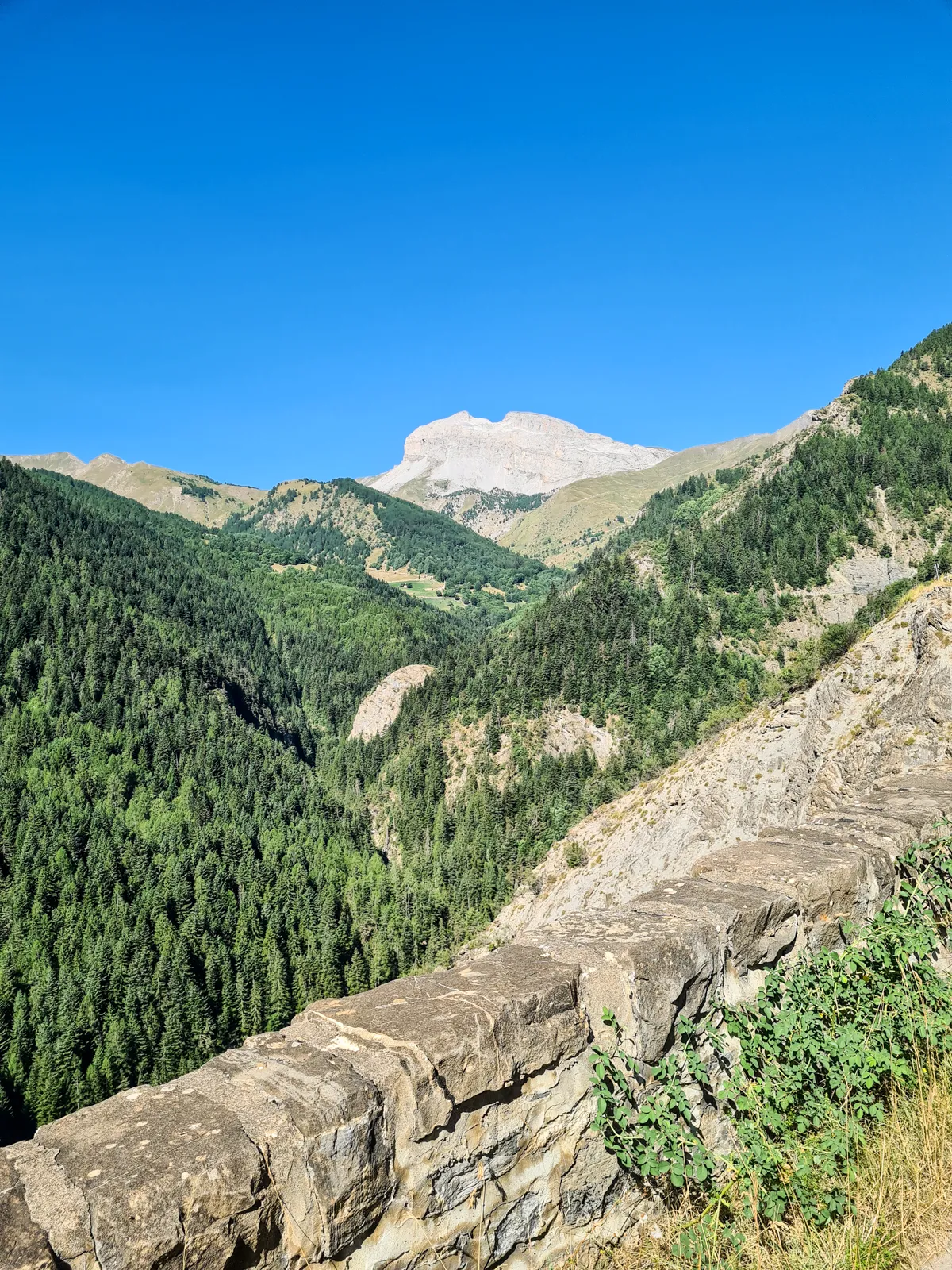
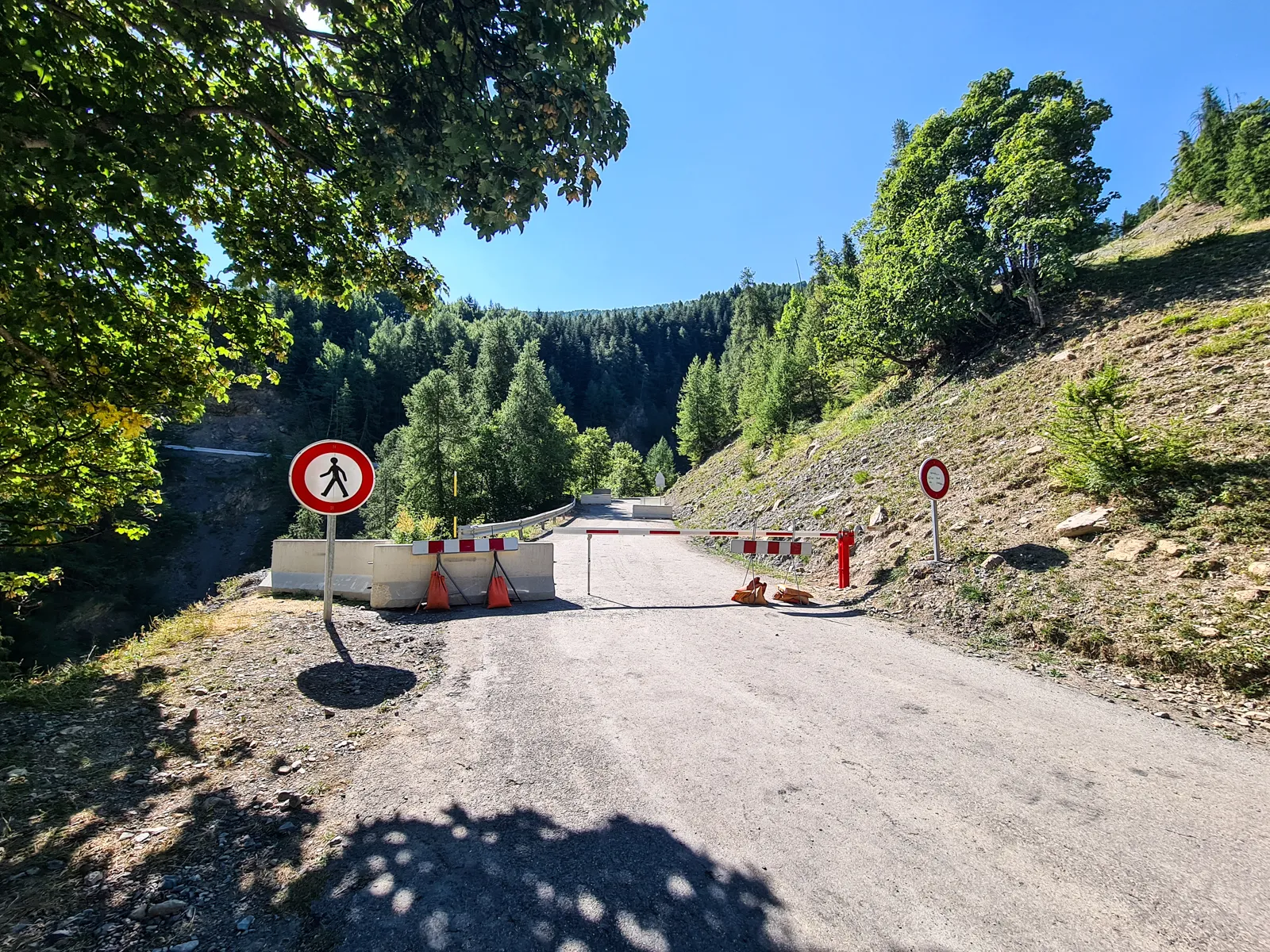
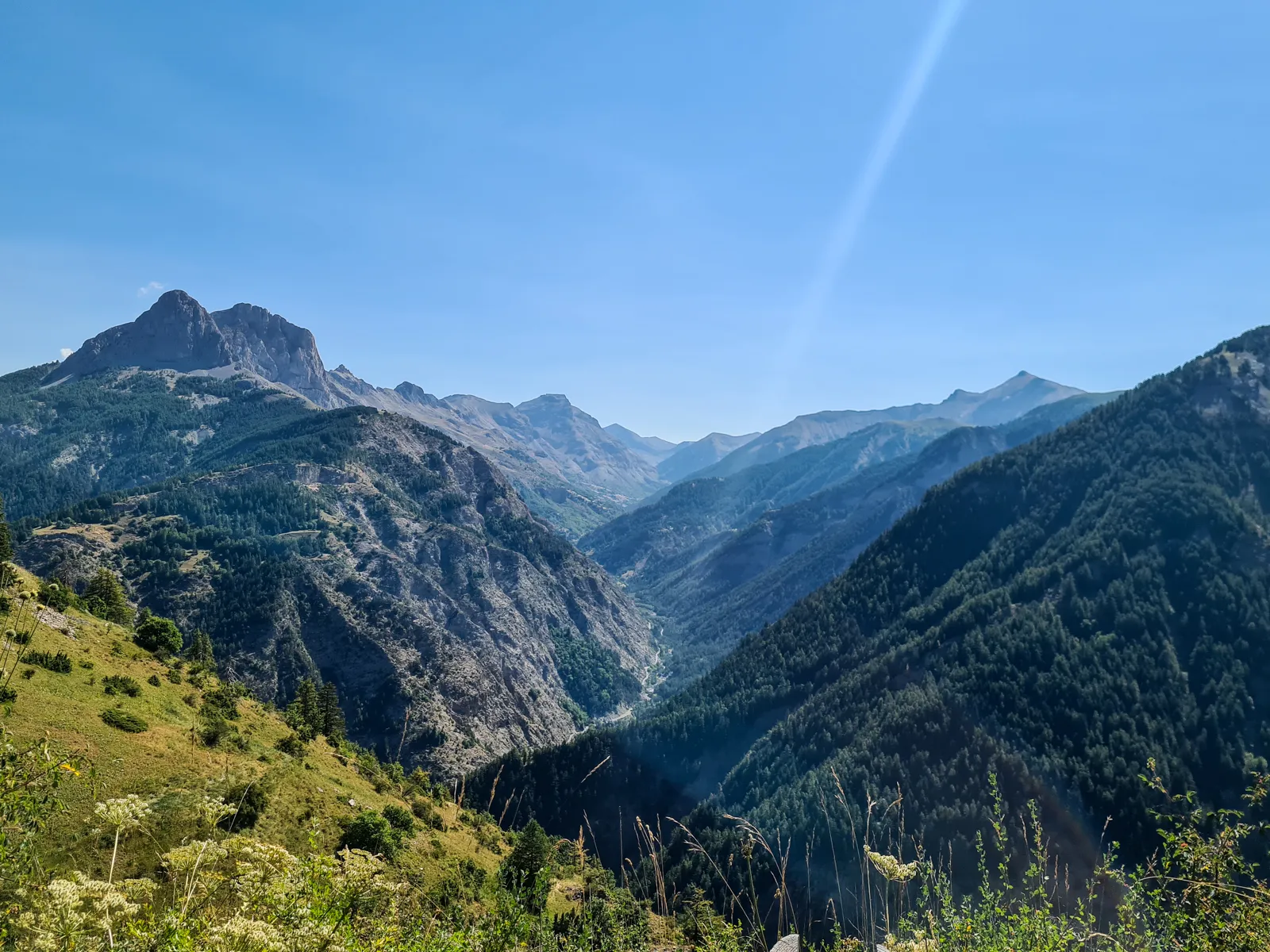
The road was in terrible shape — deep cracks, gaps in the tarmac, and missing surface segments made it a bumpy ride. Yet the sunny weather and solitude filled me with joy. I sang softly to myself and waved at grazing cows as I passed. A handful of other cyclists crossed my path, and we exchanged greetings and encouragement. Before long, I reached the windy summit, where the serpentine descent toward Colmars spread out before me, beautiful and inviting.
At the summit, I faced a choice. Continuing meant committing to the entire 150 km loop with over 3,500 meters of elevation gain. I rested, savoring the tranquility of the pass, wishing for the companionship of another rider to share the journey. Ultimately, I decided against the loop. It would be a massive effort, and the risk of total exhaustion outweighed the reward. I promised myself I’d return to complete it someday and began my descent back to Barcelonette.
In moments like that, FOMO hits the hardest. The route you’d want to take is here, waiting to be ridden. It invites you with a beautiful set of serpentines, a totally new silhouette of peaks, and a promise of even more scenic landscapes hidden behind the ridges. You’ve planned that loop long time ago, hopeful to see it in all it’s glory. But you know it would be unsustainable. You have legs for the next climb, that’s for sure. But you may still blow up after that, having over 1km of uphill to go. You don’t want to end up dragging your sorry ass over the last pass and get to the camping totally lifeless. As you turn back, you take a last sorrow look at the valley you were meant to ride, and speed down back to the safe side of the mountain.
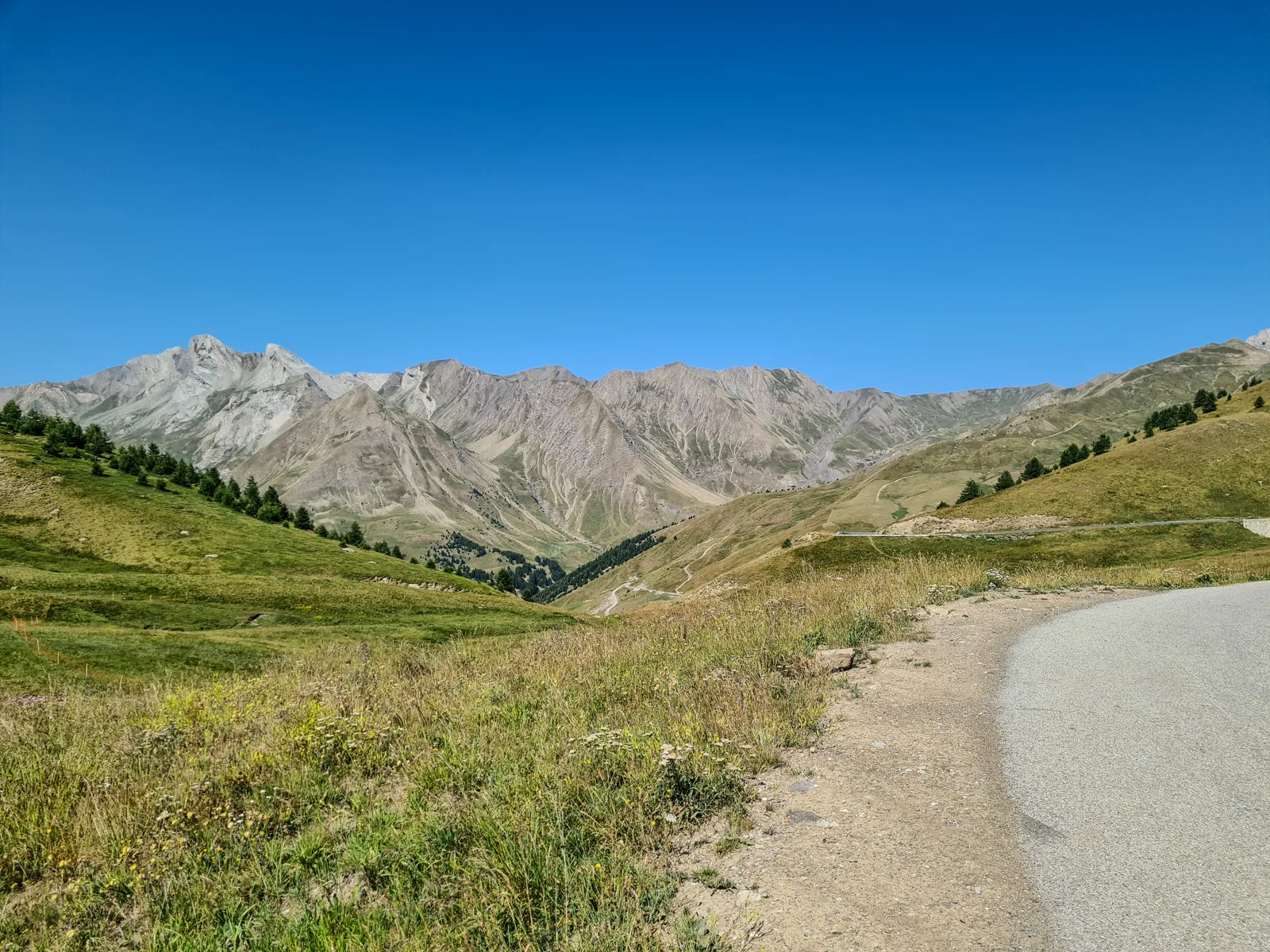
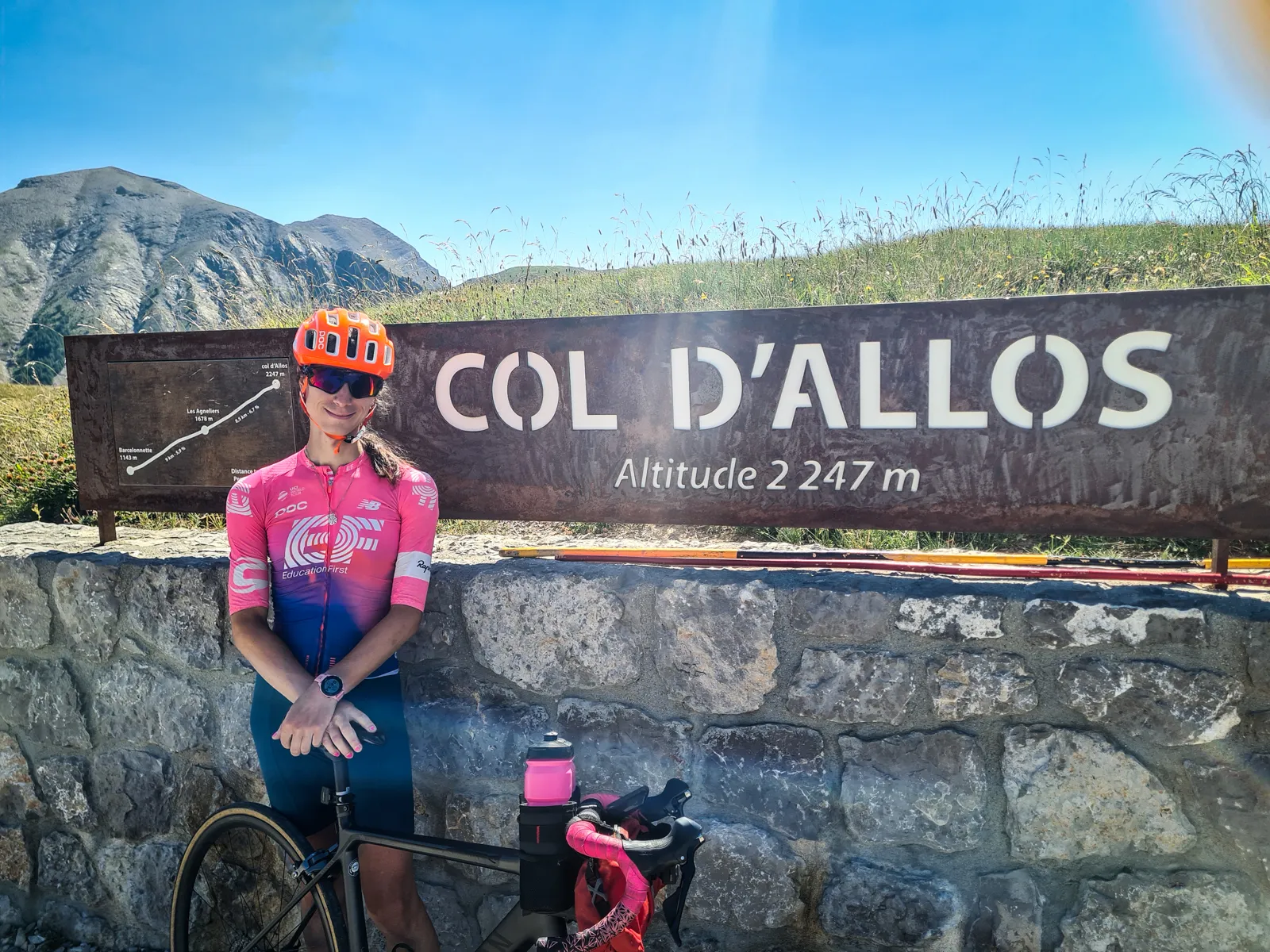
I descended slowly, very carefully navigating around all the cracks and patches in the surface. I greeted the barrier with a slight sigh of relief. Bottom part was significantly easier to ride. I still had to be careful, though. Road was very windy, narrow, and led along the middle of the cliff. Its edge was protected only by shallow barriers with gaps in between, and I wasn’t necessarily keen on checking my abilities to fly.
Back at the bottom, I still felt strong, so I turned toward the Col de la Cayolle. Unlike Allos, this climb began gently, tracing the valley floor. Sunlight filtered through the trees, and the scenery was stunning. The valley gradually narrowed into a deep gorge, its beauty captivating. I rode slowly, savoring the moment.
As the road began to climb, the warmth of the sun, the little balcony road, and the incredible views created a perfect moment — except for my dwindling water supply. I rationed carefully, taking smaller sips and spacing them out. And just when my bottles were about to run dry, help appeared: a water tap, glistening like a mirage. Relieved, I refilled my bottles and continued climbing.
The landscape transformed as I gained altitude. Dense forests gave way to alpine meadows, surrounded by jagged peaks. Beyond the treeline, the grassy tundra stretched out, punctuated by massive glacier boulders. The narrow road, light traffic, and moderate gradient made the ride peaceful and enjoyable.
At the summit, a border stone marked the transition into the Alpes Maritimes. I could almost smell the sea. As the saying goes, “the grass is greener on the other side”. The southern slope indeed seemed greener, as if teasing me with the promise of new adventures. I enjoyed a croissant, snapped a few photos, and began the long descent.
The ride back to Barcelonette was leisurely, as I lingered in the ravines, savoring the day’s magic. Returning to La Condamine, I sank into the tranquility of the campsite, ready for a complete rest day. This time, I resolved to do absolutely nothing — just stroll, read, and eat to my heart's content.
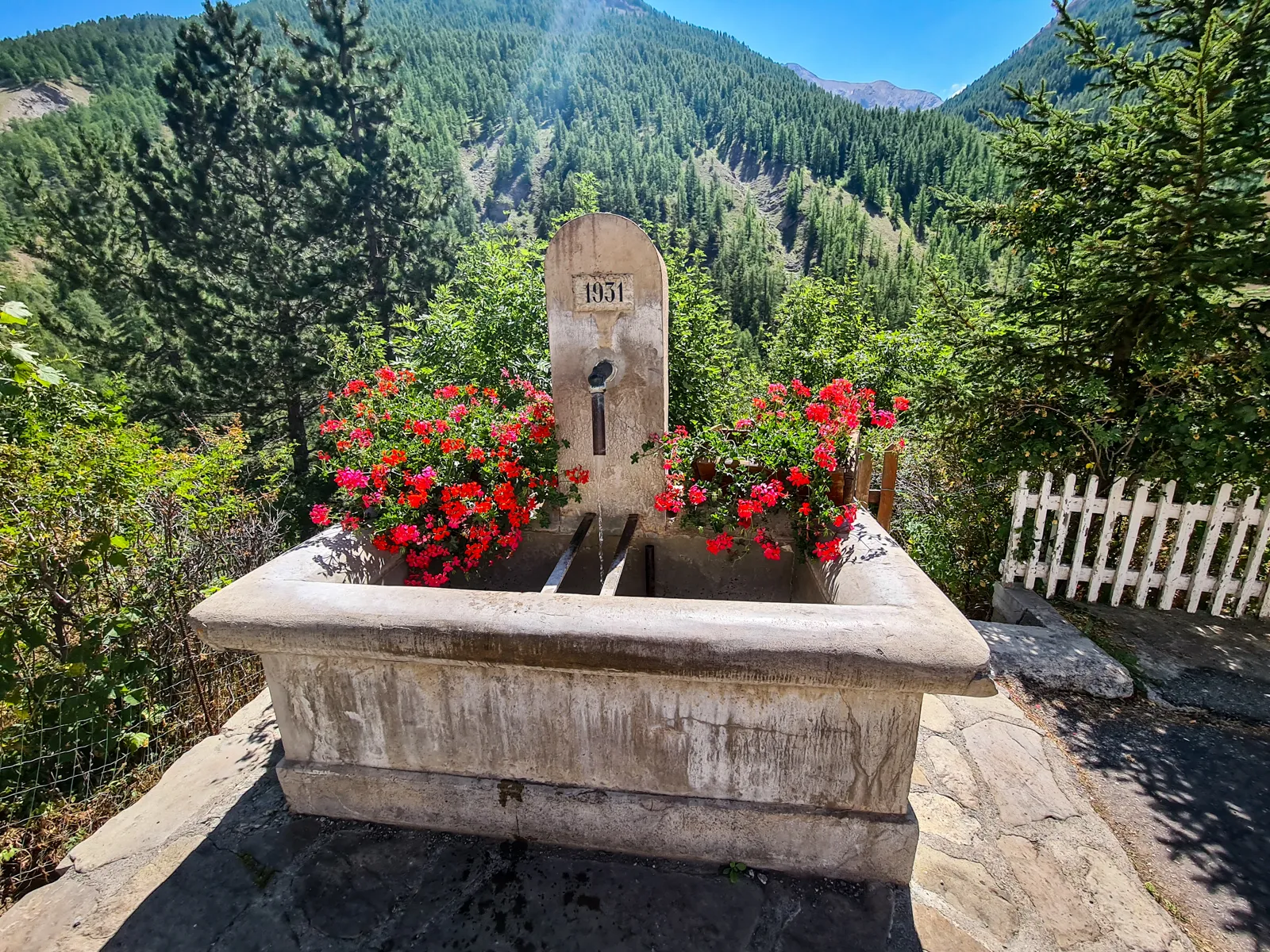
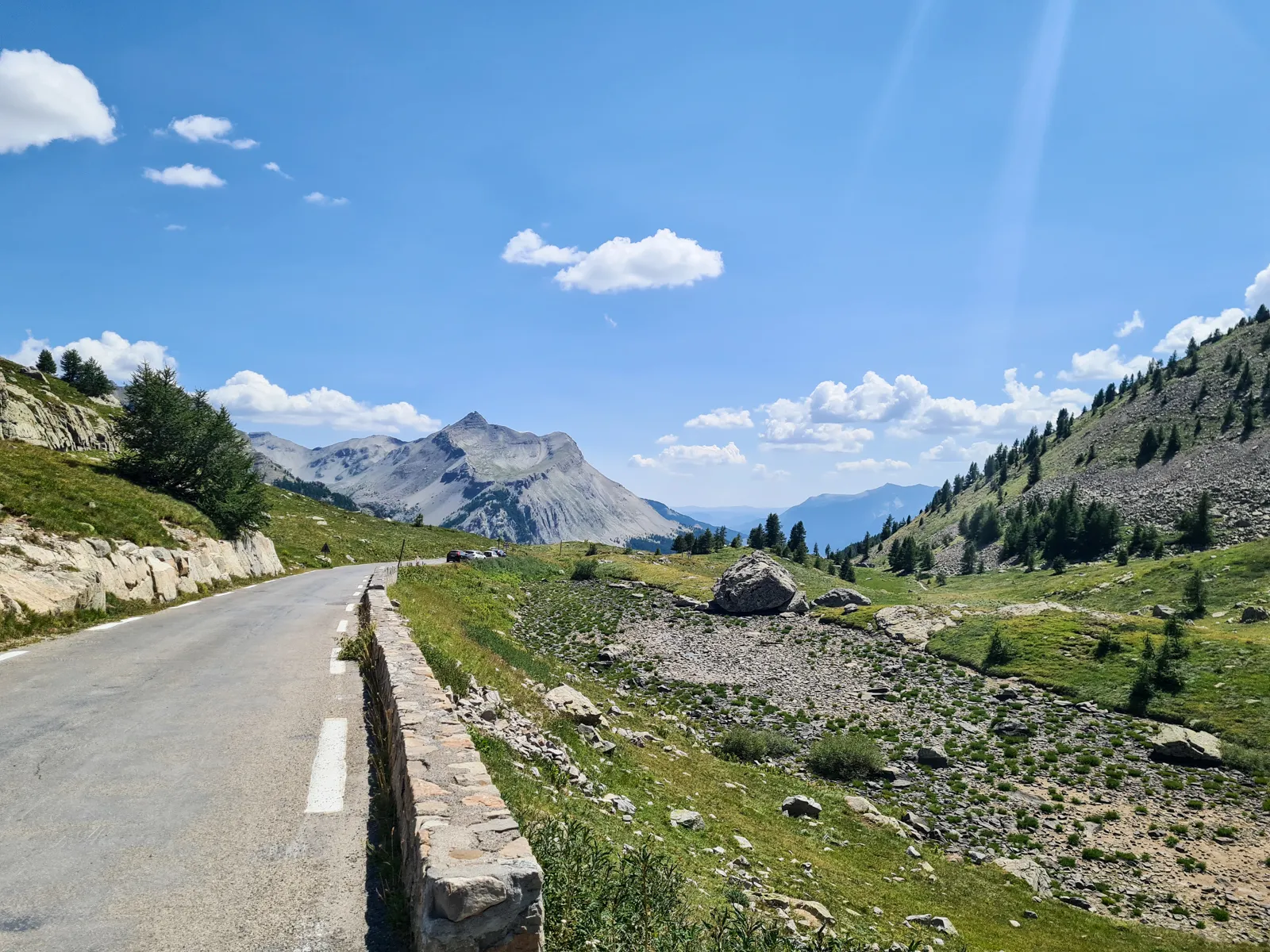
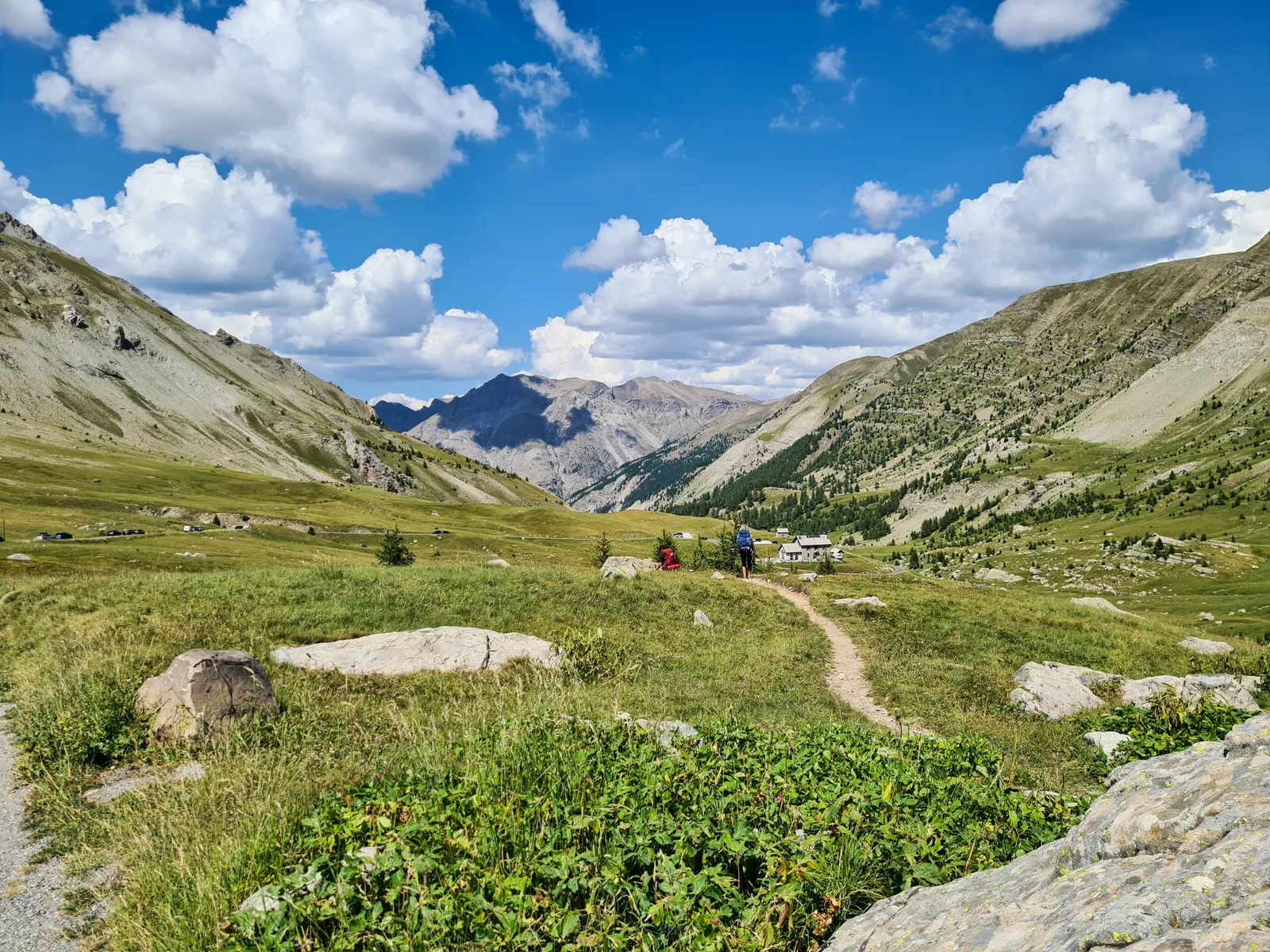
To be continued...
Strava - Stage 8 - Briançon, Vallee des Fonts, Col du Isoard
Strava - Stage 9 - Col de Vars
Strava - Stage 10 - Barcelonette, Col d'Allos, Col de la Cayolle

Previous post Tour of Alps - Part 2

